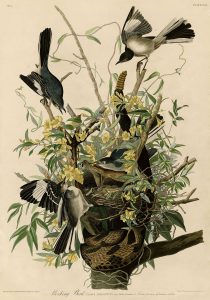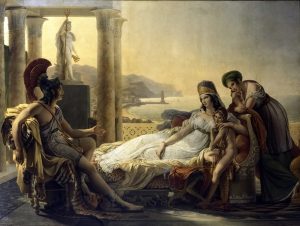The World Fairs History Table
Here are clean, organized tables of World’s Fair history, covering the major expos, grouped by century and including themes, locations, and signature achievements.
If you want, I can expand these into a printable PDF or add more fairs.
🌍 World’s Fairs History – Master Tables
1. 19th Century World’s Fairs (1851–1900)
| Year | City | Official Name | Theme / Purpose | Signature Structure | Key Achievements |
|---|---|---|---|---|---|
| 1851 | London | Great Exhibition | Industrial progress & global manufacturing | Crystal Palace | First world’s fair; industrial machines; global trade exhibit |
| 1855 | Paris | Exposition Universelle | Arts, agriculture, industry | Palais de l’Industrie | Rise of French industrial prestige |
| 1862 | London | International Exhibition | Progress in arts & industry | Western Annex | Textiles, telegraphy |
| 1867 | Paris | Exposition Universelle | National pavilions (first time) | Oval iron-and-glass palace | Cultural exchange innovation |
| 1873 | Vienna | Weltausstellung | Industry & modern cities | Rotunde | Urban planning focus |
| 1876 | Philadelphia | Centennial Exhibition | 100 years of U.S. industry | Memorial Hall | Telephone debut; typewriter |
| 1878 | Paris | Exposition Universelle | Third Republic prestige | Trocadéro Palace | Electric lighting displays |
| 1880 | Melbourne | International Exhibition | Colony development | Royal Exhibition Bldg | Largest 19th-century building in Aus |
| 1889 | Paris | Exposition Universelle | French Revolution centennial | Eiffel Tower | Modern engineering revolution |
| 1893 | Chicago | Columbian Exposition | 400 years after Columbus | Ferris Wheel, “White City” | AC electricity; City Beautiful movement |
| 1900 | Paris | Exposition Universelle | New century optimism | Grand Palais, Petit Palais | Moving sidewalks; escalators |
2. Early 20th Century Fairs (1901–1938)
| Year | City | Official Name | Theme | Signature Structure | Key Achievements |
|---|---|---|---|---|---|
| 1904 | St. Louis | Louisiana Purchase Expo | Expansion & technology | Festival Hall | X-ray displays; the ice cream cone popularized |
| 1910 | Brussels | Exposition Universelle | International culture | Colonial Palace | Belgium’s global ambitions |
| 1929–30 | Barcelona | International Exposition | Art & architecture | Mies Pavilion | Birth of modernist architecture |
| 1933–34 | Chicago | Century of Progress | Science & industry | Sky Ride | Art Deco + technology fusion |
| 1935 | Brussels | Exposition Universelle | Modern culture | Palais du Centenaire | Urban development |
| 1937 | Paris | Exposition Internationale | Art & technology | Soviet & German pavilions | Picasso’s Guernica displayed |
| 1939–40 | New York | World of Tomorrow | Futurism, consumer tech | Trylon & Perisphere | Public debut of TV; modernist future vision |
| 1940 | San Francisco | Golden Gate Expo | Pacific unity | Treasure Island buildings | West Coast technology |
3. Mid-Late 20th Century Fairs (1950–1999)
| Year | City | Official Name | Theme | Signature Structure | Key Achievements |
|---|---|---|---|---|---|
| 1958 | Brussels | Expo 58 | Atomic Age | Atomium | First postwar expo; Cold War science |
| 1962 | Seattle | Century 21 Expo | Space Age | Space Needle | Futurism, monorails |
| 1964–65 | New York | World’s Fair | Peace & progress | Unisphere | Robotics, space tech |
| 1967 | Montreal | Expo 67 | “Man and His World” | Geodesic Dome, Habitat 67 | One of the most successful expos ever |
| 1970 | Osaka | Expo ’70 | Progress & harmony | Tower of the Sun | First World Fair in Asia |
| 1992 | Seville | Universal Exposition | Discoveries of the world | Bridges & pavilions | Cultural exchange |
| 1998 | Lisbon | Expo ’98 | Oceans & exploration | Oceanarium | Marine science focus |
4. 21st Century World’s Fairs (2000–Present)
| Year | City | Theme | Signature Structure | Notes |
|---|---|---|---|---|
| 2005 | Aichi (Japan) | Nature’s wisdom | Global House | Sustainability emphasis |
| 2010 | Shanghai | Better city, better life | China Pavilion | Largest expo ever |
| 2015 | Milan | Feeding the planet | Tree of Life | Food systems & sustainability |
| 2020 (held 2021–22) | Dubai | Connecting minds | Al Wasl Dome | First expo in the Middle East |
| 2025 | Osaka | Designing a future society | Floating ring arena | Theme: “Saving Lives” |
Want More?
I can make any of the following:
📊 A single giant comparison table
🗺️ A map showing expo locations over time
📘 A blog-ready article on World’s Fairs
📄 A printable PDF document
📅 A chronological timeline chart
Just tell me your preferred format!
The Five Greatest World Fairs
While “greatest” is subjective, the most influential World’s Fairs are those that set a new standard, left behind a world-famous icon, or captured a pivotal moment in history.
Here are five of the greatest and most transformative World’s Fairs.
1. 🏛️ London 1851: The Great Exhibition
Theme: “Great Exhibition of the Works of Industry of All Nations” Icon: The Crystal Palace
This was the first true international World’s Fair, and it set the template for all others. Housed in the revolutionary Crystal Palace—a massive structure of cast iron and glass—it was a celebration of the Industrial Revolution. It showcased the best of manufacturing, science, and art, establishing the fair as a venue for nations to display their technological prowess and cultural identity.
2. 🗼 Paris 1889: Exposition Universelle
Theme: Celebrating the 100th anniversary of the French Revolution Icon: The Eiffel Tower
This fair is famous for giving the world its most recognizable landmark. The Eiffel Tower served as the exposition’s grand entrance arch and was a staggering feat of engineering, becoming the tallest man-made structure in the world. The fair showcased the wonders of the new “Age of Steel” and electricity, firmly establishing Paris as a global center of art and technology.
3. 🎡 Chicago 1893: World’s Columbian Exposition
Theme: Celebrating the 400th anniversary of Columbus’s arrival Icon: The “White City” and the original Ferris Wheel
This fair was a profound moment for America. It was a massive, elaborately designed fairground known as the “White City,” featuring gleaming white neoclassical buildings that launched the “City Beautiful” architectural movement across the United States. It also introduced major technological innovations to the public, including the first-ever Ferris Wheel and the widespread adoption of alternating current electricity, both showcased by Westinghouse.
4. 🚀 New York 1939-40: The World of Tomorrow
Theme: “Building the World of Tomorrow” Icon: The Trylon and Perisphere
Opening just months before the start of World War II, this fair was a spectacular, optimistic vision of the future. Its most famous exhibits, General Motors’ “Futurama” and the “Democracity” diorama, presented a new American dream built around superhighways, suburbs, and consumer technology. It was less about present-day achievements and more about a utopian blueprint for the post-war world, which heavily influenced the 1950s.
5. 🌍 Montreal 1967: Expo 67
Theme: “Man and His World” Icon: Habitat 67 and the Geodesic Dome
Often cited as the most successful and optimistic World’s Fair of the 20th century, Expo 67 celebrated Canada’s centennial. It was a cultural and architectural triumph. It featured the U.S. pavilion, a massive geodesic dome designed by Buckminster Fuller, and the revolutionary Habitat 67 housing complex, which re-imagined urban living. The fair’s hopeful, humanist theme and vibrant atmosphere perfectly captured the spirit of the 1960s.
🏛️ London 1851: The Great Exhibition
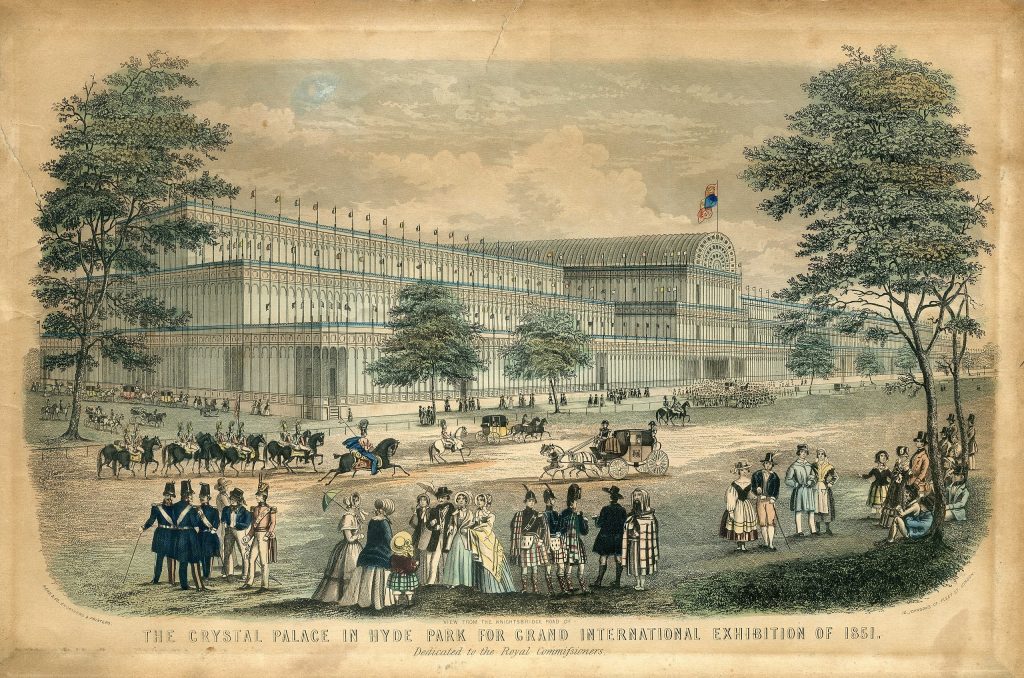
View from the Knightsbridge Road of The Crystal Palace in Hyde Park for the Grand International Exhibition of 1851. Dedicated to the Royal Commissioners., London: Read & Co. Engravers & Printers, 1851.
(Wiki Image By Read & Co. Engravers & Printers – View from the Knightsbridge Road of The Crystal Palace in Hyde Park for the Grand International Exhibition of 1851. Dedicated to the Royal Commissioners., London: Read & Co. Engravers & Printers, 1851., Public Domain, https://commons.wikimedia.org/w/index.php?curid=48718934)
🏛️ London 1851: The Great Exhibition Quotes
Here are some of the most famous and representative quotes from and about the 1851 Great Exhibition, capturing the event’s sense of wonder, industrial purpose, and cultural impact.
🏛️ Queen Victoria (From her personal diary)
Queen Victoria’s diary entry for the opening day, May 1, 1851, is the most famous first-hand account, filled with emotion and awe.
“This day is one of the greatest and most glorious days of our lives, with which, to my pride and joy, the name of my dearly beloved Albert is forever associated!
…The sight as we came to the centre, where the steps and chair… were placed, facing the beautiful crystal fountain, was magic and impressive. The tremendous cheering, the joy expressed in every face, the vastness of the building, with all its decorations and exhibits… and my beloved Husband, the creator of this great ‘Peace Festival,’ uniting the industry and art of all nations of the earth.
God bless my dearest Albert, and my dear Country, which has shown itself so great today.”
👑 Prince Albert (The Organizer)
In a 1850 speech, Prince Albert, the chief organizer, laid out his grand, idealistic vision for the exhibition’s purpose.
“We are living in a period of the most wonderful transition… The distances which separate the different nations and parts of the globe are rapidly vanishing…
I therefore conceive it to be the duty of every educated person to close… the Utopian dream of the ‘Unity of Mankind’… The Exhibition of 1851 is to give us an actual test and a living picture of the point of development at which the whole of mankind has arrived… and a new starting-point from which all nations will be able to direct their further exertions.”
✍️ Charles Dickens (The Overwhelmed Visitor)
The novelist Charles Dickens, known for his critiques of industrial society, captured the exhibition’s overwhelming, almost maddening scale in a letter.
“I find I am ‘used up’ by the Exhibition. I don’t say ‘there’s nothing in it’ — there’s too much. I have only been twice. So many things bewildered me. I have a natural horror of sights, and the fusion of so many sights in one has not decreased it.”
🕊️ The Duke of Wellington (The Pragmatist)
This famous anecdote illustrates the practical problems of the Crystal Palace. When Queen Victoria complained that birds were nesting in the enormous elm trees enclosed within the hall, she asked the aged Duke of Wellington for advice. His curt, practical solution has become legendary.
“Try sparrowhawks, Ma’am.”
📰 Contemporary Press
A contemporary writer for the Great Exhibition Prize Essay (1851) summed up the immense public excitement and scale of the event:
“We are upon the eve of an event which may certainly be looked upon as the greatest wonder of the world.”
🏛️ London 1851: The Great Exhibition History
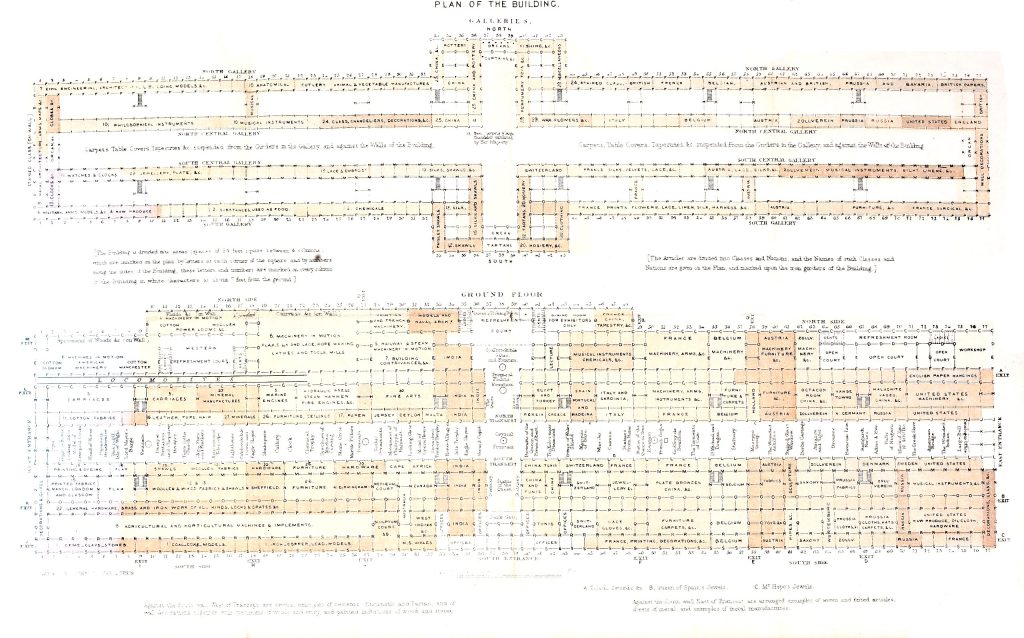
Plan of the exhibition
(Wiki Image By Unknown – Plan of the building, Great Exhibition, 1851, Public Domain, https://commons.wikimedia.org/w/index.php?curid=169686221)
Here’s the history of the 1851 Great Exhibition.
The First World’s Fair
The Great Exhibition of the Works of Industry of All Nations was the first international “World’s Fair.” It was a massive cultural and industrial spectacle designed to showcase the technological wonders and manufactured goods of the age.
The Organizers and Purpose
The event was the brainchild of Prince Albert (Queen Victoria’s husband) and Henry Cole, a civil servant and inventor. Their primary goals were to:
- Celebrate the Industrial Revolution: It was a grand stage for the new technologies in steam, manufacturing, and science.
- Assert British Superiority: While it invited “all nations,” the exhibition was explicitly designed to prove that Great Britain was the undisputed leader in industry, engineering, and commerce.
- Promote Free Trade: It was a celebration of global commerce and the idea that open trade would lead to world peace.
The Crystal Palace
The building itself was the main attraction. After a failed design competition, gardener and architect Joseph Paxton submitted a revolutionary plan.
- Design: His building, nicknamed the “Crystal Palace,” was a marvel of pre-fabricated engineering.
- Materials: It was built entirely from cast iron and glass.
- Scale: At 1,851 feet long (a nod to the year), it was a gigantic “glass house” large enough to enclose several fully grown elm trees that were on the site, sparing them from being cut down.
The Exhibition Itself
The fair ran from May 1 to October 15, 1851, in London’s Hyde Park. It was an unprecedented success.
- Exhibits: It featured over 100,000 objects from 14,000 exhibitors, half from Britain and its empire, and half from foreign nations. Wondrous exhibits included:
- The Koh-i-Noor Diamond was recently acquired from India.
- The “Express” Steam Locomotive (the Lord of the Isles).
- The “Greek Slave” statue is a sensational American work of art.
- New technologies like the electric telegraph and the first public, pay-to-use flushing toilets (the “Spending a Penny” origin).
- Attendance: Over six million people (a third of Britain’s population) visited, including figures like Charles Darwin, Charlotte Brontë, and Charles Dickens.
The Legacy
The Great Exhibition was a massive financial success, turning a profit of £186,000 (equivalent to tens of millions in today’s money). This “surplus” was used to create a permanent cultural and educational center in London.
Prince Albert and the Royal Commission used the funds to purchase 87 acres of land in South Kensington. On this land, they founded what would become:
- The Victoria and Albert Museum (V&A)
- The Science Museum
- The Natural History Museum
- The Royal Albert Hall
- Imperial College London
The Crystal Palace was dismantled and moved to South London, where it stood as a cultural center for decades until it was destroyed by fire in 1936.
Henry Cole conceived, and Sir Joseph Paxton built the Crystal Palace

Joseph Paxton’s first sketch for the Great Exhibition Building, c. 1850, using pen and ink on blotting paper; Victoria and Albert Museum
(Wiki Image By Original uploader was VAwebteam at en.wikipedia – Transferred from en.wikipedia, CC BY-SA 3.0, https://commons.wikimedia.org/w/index.php?curid=12829612)
That is the correct way to frame it! They were the dynamic duo behind the 1851 Great Exhibition. It was a partnership of Concept (Cole) and Execution (Paxton).
Here is how their collaboration created the most famous building of the Victorian age.
1. The Problem: “A Wee Bit Behind Schedule.”
By 1850, Henry Cole’s dream of a Great Exhibition was turning into a nightmare.
-
The Deadline: The exhibition was scheduled for May 1, 1851.
-
The Failure: The Building Committee (led by engineers such as Isambard Kingdom Brunel) rejected 245 designs. They eventually produced their own design, a massive brick structure that would have taken years to build and required 30 million bricks.
-
The Crisis: With less than a year to go, they had no building, no plan, and public ridicule was mounting.
2. The Solution: The “Blotting Paper” Sketch
Joseph Paxton was an outsider—a gardener, not an architect. But he had experience building large glasshouses for the Duke of Devonshire (like the Great Stove at Chatsworth).
-
The Meeting: Paxton visited London and heard about the crisis. He told a committee member he could design a building in 9 days.
-
The Sketch: During a railway board meeting on June 11, 1850, while others were talking business, Paxton doodled his idea on a piece of pink blotting paper. It showed a modular structure based on the leaf structure of the giant water lily (Victoria amazonica).
-
The Pitch: Henry Cole immediately recognized the plan’s genius. It was light, cheap, and fast. Cole used his influence to bypass the skeptical committee and get Prince Albert’s approval.
3. The Construction: The “Giant Lego Set.”
Because of Paxton’s modular design and Cole’s organizational skills, the construction was a logistical miracle.
-
Prefabrication: Everything was made in factories in Birmingham and shipped to Hyde Park.
-
300,000 panes of glass.
-
4,500 tons of iron.
-
-
The Glazing Wagons: Paxton invented special trolleys that rode on the roof gutters, allowing workers to install 108 panes of glass per day per man.
-
The Trees: A primary objection was that the park’s elm trees would be cut down. Paxton designed the barrel-vaulted roof (the transept) to be tall enough (108 feet) to enclose the full-grown trees inside the building.
4. The Result
-
Speed: It went from a doodle to a finished building in just 9 months.
-
Size: It was 1,848 feet long (referencing the year 1848) and covered 19 acres.
-
Success: It was the first time the world had seen such a massive enclosed space full of light. It made a profit of £186,000 (which was used to buy the land for the Natural History Museum and V&A).
Summary of the Partnership
-
Henry Cole navigated the politics. He fought the critics, managed the Queen, and kept the committee from killing the project.
-
Joseph Paxton solved the engineering problem. He provided the revolutionary design that made the impossible timeline possible.
Would you like to know about the “Sparrowhawk Problem”—when birds got trapped inside the Crystal Palace and the Queen asked the Duke of Wellington for a solution?
🏛️ London 1851: The Great Exhibition. Eight Wondrous Exhibition
The 1851 Great Exhibition in London was a celebration of the Industrial Revolution, designed to showcase “the Works of Industry of All Nations.” The greatest wonder was arguably the exhibition hall itself: The Crystal Palace.
This revolutionary building, made of cast iron and glass, was a marvel of pre-fabricated architecture. At 1,851 feet long, it was a gigantic greenhouse large enough to enclose fully grown elm trees that were on the site.
Inside, it contained over 100,000 exhibits. Here are eight of the most famous and wondrous exhibits that captivated the six million visitors.
8 Wonders of the Great Exhibition
| Exhibit | Origin | Significance & “Wonder” |
| 1. The Koh-i-Noor Diamond | India / British Empire | This was one of the largest diamonds in the world and the single most popular attraction. Recently acquired by Britain, it was a potent symbol of imperial power. Its poor display, however, led to it being re-cut after the exhibition. |
| 2. The “Express” Steam Locomotive | United Kingdom | A full-size, powerful, 40-ton “Lord of the Isles” locomotive was displayed inside the hall. It was a massive, tangible symbol of the speed, power, and engineering prowess of the new industrial age. |
| 3. The “Greek Slave” Statue | United States | This marble statue by Hiram Powers depicted a nude Greek woman in chains. It was the most famous and controversial artwork at the fair, drawing huge crowds and sparking intense debates about nudity, art, and slavery. |
| 4. McCormick’s Reaper | United States | This was a true world-changing invention. The horse-drawn reaping machine could harvest grain far faster than any human, and it won a gold medal, heralding the mechanization of agriculture and the rise of American industrial power. |
| 5. Colt’s Repeating Revolver | United States | Samuel Colt’s display of his new revolving-cylinder firearms was a sensation. It demonstrated the new “American system” of mass production using interchangeable parts, and the pistols became a must-have for adventurous Britons. |
| 6. The Electric Telegraph | United Kingdom | Cooke and Wheatstone’s system was on full display. Visitors were amazed by this “wonder” of instant communication, which allowed messages to be sent from one end of the massive building to the other in seconds. |
| 7. Russian Malachite Doors | Russia | An opulent and non-industrial “wonder.” The Russian exhibit featured a set of colossal, ornate doors and massive urns made from brilliant green malachite. They were a breathtaking display of luxury and natural resources from another empire. |
| 8. The Tempest Prognosticator | United Kingdom | A whimsical and truly “Victorian” invention. It was an elaborate barometer that used live leeches in small jars. When a storm approached, the leeches would become agitated and climb, triggering a small bell. |
London 1851: The Great Exhibition. The Koh-i-Noor Diamond
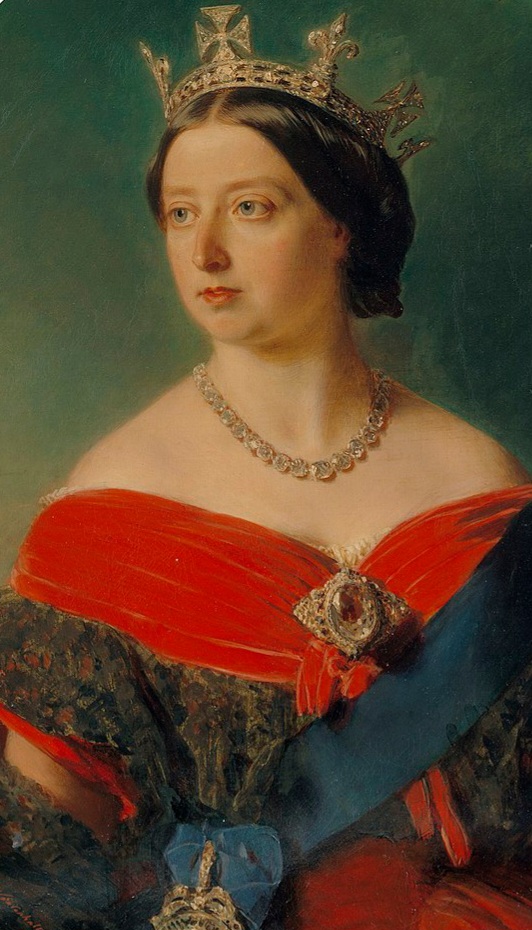
Queen Victoria wearing the Koh-i-Noor as a brooch, by Franz Xaver Winterhalter
(Wiki Image By Franz Xaver Winterhalter – This image has been extracted from another file, Public Domain, https://commons.wikimedia.org/w/index.php?curid=100483067)
The Koh-i-Noor (“Mountain of Light”) diamond was arguably the single most famous, popular, and controversial exhibit at the 1851 Great Exhibition. It was its “star attraction,” but its appearance famously underwhelmed the public.
A Symbol of Imperial Power
The diamond’s presence was a raw display of British imperial power. It had been formally surrendered to Queen Victoria just two years earlier (1849) by the Sikh Empire as part of the Treaty of Lahore, which ended the Second Anglo-Sikh War.
Its exhibition in the Crystal Palace was not just a display of a rare gem; it was a potent symbol of Britain’s conquest of India and its status as a global empire.
The Disappointing Display
For all its fame, the public’s reaction was one of mass disappointment.
- Security: The diamond was displayed in a large, ornate, gilt “birdcage” or safe designed by Chubb, the famous locksmith. It was heavily guarded and placed on a velvet cushion.
- The Problem: The gem itself failed to impress. At the time, it had an older, 186-carat “Mughal cut” (its original form). This style had a large, flat top and did not sparkle like modern cuts.
- The Reaction: Under the vast, diffused light of the Crystal Palace, the diamond looked dull, listless, and lifeless. Visitors, expecting a blinding sparkle, complained it looked like a simple piece of glass or “a dull lump of crystal.” The press mocked the lackluster display.
The Aftermath: A Drastic Re-Cutting
The public relations failure of its 1851 exhibition led directly to the diamond’s transformation. In 1852, Prince Albert (Queen Victoria’s husband) ordered that the diamond be re-cut.
This process, which took 38 days and cost £8,000, dramatically altered the stone. It was cut down by over 40% to its current 105.6 carats, but transformed into a much shallower, brilliant-cut oval, giving it the dazzling fire and sparkle the 1851 crowds had expected.
London 1851: The Great Exhibition. The “Express” Steam Locomotive
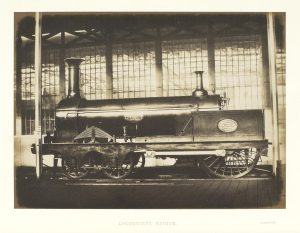
SER No. 136, Folkstone, with an intermediate crankshaft at the Great Exhibition in 1851.
(Wiki Image By William Henry Fox Talbot – Bonhams, Public Domain, https://commons.wikimedia.org/w/index.php?curid=27547909)
The “Express” steam locomotive you’re referring to was the “Lord of the Isles,” one of the most potent and impressive industrial exhibits at the 1851 Great Exhibition.
It was a massive, 40-ton broad-gauge engine built by the Great Western Railway (GWR). Its presence inside the delicate Crystal Palace was a stunning demonstration of British engineering and the sheer power of the Industrial Revolution.
Why It Was a “Wonder”
- Symbol of Speed and Power: The “Lord of the Isles” was a state-of-the-art “express” engine, built to pull passenger trains at high speeds. It was a tangible, colossal symbol of the new railway age, shrinking the country and changing daily life.
- Engineering Prowess: It was considered the pinnacle of locomotive design at the time. Its sleek design and massive 8-foot-diameter driving wheel represented the height of British industrial might, a key theme of the exhibition.
- A Spectacle of Scale: A significant part of the “wonder” was the audacity of placing a full-size, 40-ton piece of heavy machinery inside the elegant, glass-and-iron exhibition hall. It created a powerful contrast between heavy industry and fine art, all housed under one roof.
The locomotive was so successful as an exhibit that it was awarded a gold medal. It went on to have a long service career with the GWR after the fair concluded.
London 1851: The Great Exhibition. The “Greek Slave” Statue
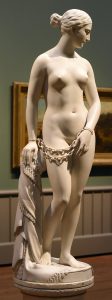
The Greek Slave by Hiram Powers at the Yale Art Gallery.
(Wiki Image By Karl Thomas Moore – derivative work of File: The Greek Slave by Hiram Powers at Yale.jpg, CC BY-SA 4.0, https://commons.wikimedia.org/w/index.php?curid=69473799)
“The Greek Slave” was one of the most sensational and talked-about exhibits at the 1851 Great Exhibition. It was a full-size, white marble statue by the American sculptor Hiram Powers.
What It Was
The statue depicted a nude Greek woman, standing in a classical pose, with her hands bound in chains. According to the artist’s narrative, she was a Christian captive of the Ottoman Turks, about to be sold at a slave market. She holds a locket (a cross) in her hand, a symbol of her faith.
Why It Was a “Wonder” (and a Scandal)
- The Nudity: It was a full, frontal female nude, which was a “shock” to the modest Victorian public. This made it an immediate source of scandal and fascination.
- The “Acceptable” Narrative: Powers’s backstory was a brilliant piece of marketing. The statue’s nudity was not portrayed as immodest or erotic; it was a sign of her humiliation and helplessness. Because she was a Christian and her nudity was forced upon her by “infidel” captors, the Victorian audience was given a “moral” reason to gaze at the statue. They could feel pity and righteous indignation, rather than “improper” titillation.
- Mass Popularity: The controversy made it a must-see. It was arguably the most famous single work of art at the exhibition, drawing enormous crowds and endless press coverage. Queen Victoria herself viewed it and approved.
- American Symbolism: As the most prominent American artwork at the fair, it was also a source of national pride. In the U.S., it was sometimes co-opted by abolitionists, who used the image of a white slave to comment on the hypocrisy of American slavery (though Powers himself was not an abolitionist).
London 1851: The Great Exhibition. McCormick’s Reaper
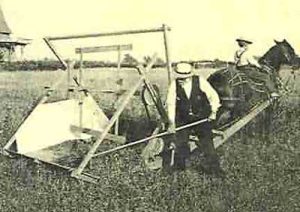
McCormick’s reaper
(Wiki Image By Unknown author – http://www.wynalazki.mt.com.pl/duze/zniwiar.html, Public Domain, https://commons.wikimedia.org/w/index.php?curid=847543)
The McCormick Reaper was one of the most significant and world-changing inventions displayed at the 1851 Great Exhibition. It was a horse-drawn machine, invented by Cyrus McCormick, that could harvest grain far faster and more efficiently than human laborers with scythes.
A “Clumsy” Start
When the reaper was first put on display at the Crystal Palace, the British public and press were unimpressed. Compared to the ornate and polished industrial goods of Britain, the American machine looked rough, clumsy, and out of place. The Times of London famously mocked it as “a cross between an Astley’s chariot, a wheelbarrow, and a flying machine.”
The Turning Point: The Field Trial
The exhibition’s organizers, wanting to give the machine a fair chance, arranged for a public field trial at Tiptree Farm outside London. On a damp, drizzly day, the reaper was put to work on a field of wet wheat.
To the crowd’s astonishment, the machine performed flawlessly. It cut a swath of wheat cleanly and quickly, doing the work of over a dozen men. The public’s mockery turned to stunned admiration overnight. The reaper was no longer a joke; it was a revolution.
Significance at the Fair
The McCormick Reaper’s triumph was a pivotal moment.
- It Won a Gold Medal: After its successful demonstration, the reaper was awarded a Council Gold Medal, one of the exhibition’s highest honors.
- It Heralded Mechanized Agriculture: The machine was the single best symbol of the coming mechanization of agriculture, which would change the world by making food cheaper and more plentiful.
- It announced American Ingenuity: The reaper’s success was a turning point for American industry. It proved that the United States was no longer just a rustic backwater but a new, rising industrial power capable of producing practical, world-changing innovations.
London 1851: The Great Exhibition. Colt’s Repeating Revolver

Colt 1851 Navy Revolving Pistol, serial no 2
(Wiki Image By Samuel Colt – This file was donated to Wikimedia Commons as part of a project by the Metropolitan Museum of Art. See the Image and Data Resources Open Access Policy, CC0, https://commons.wikimedia.org/w/index.php?curid=65048310)
Samuel Colt’s exhibit of his repeating revolver was one of the most talked-about displays at the Great Exhibition, and it was a sensation for two reasons.
The first, and most obvious, was the gun itself. The Colt Navy revolver was a sleek, powerful, and (most importantly) reliable multi-shot personal weapon. It was seen as a symbol of the rugged American frontier, and its mechanism fascinated the British public.
The Real “Wonder”: Interchangeable Parts
The true marvel of Colt’s exhibit, however, was not just the gun, but how it was made.
At the time, British gunmakers were artisans who hand-filed and fitted every single part. Each gun was a unique, bespoke object, and its parts would not fit any other weapon.
Samuel Colt, by contrast, was a pioneer of the “American system of manufacturing.” He demonstrated that his revolvers were mass-produced using precision machinery, producing thousands of identical, interchangeable parts.
To prove this, Colt famously:
- Disassembled several of his revolvers.
- Mixed all the parts into a jumble on the table.
- Quickly reassembled several working guns from the random pile, with no hand-filing needed.
This demonstration of mass production was a shock to the British industrial establishment. It proved that the United States was a new and serious manufacturing power. Colt’s exhibit was so successful that it won a gold medal, and he was soon invited to open a large Colt factory in London to produce firearms for the British military.
London 1851: The Great Exhibition. The Electric Telegraph

Cooke & Wheatstone’s double-needle telegraph, 1850
https://distantwriting.co.uk/electrictelegraphcompany.html
The electric telegraph was one of the true technological marvels of the 1851 Great Exhibition, representing the “wonder” of instantaneous communication.
It wasn’t a single object but rather a prominent demonstration of a working system. The leading exhibitors were the Electric Telegraph Company, which held the patents for the Cooke and Wheatstone system, the dominant technology in Britain.
Why It Was a “Wonder”
- Instant, “Magical” Communication: For a public that still relied on horse-drawn mail, the idea of sending a message from one place to another in a fraction of a second was pure magic. The exhibit made this abstract idea tangible.
- A Working System: The company didn’t just display the machines; they ran live, working wires throughout the vast Crystal Palace. Visitors could see messages being sent and received in real-time.
- Connecting to the Outside World: The exhibit was connected to the rapidly expanding national telegraph network. This meant the Crystal Palace was, for the first time, in instant communication with major cities across Great Britain. Visitors could see (and in some cases, send) messages to and from London, Edinburgh, Manchester, and other cities, demonstrating the system’s practical power.
- Novelty and “The Future”: Along with the locomotive, the telegraph was the clearest symbol of a new, fast-paced, and interconnected future. It was a significant draw, and the company’s “telegraph office” became a popular meeting point.
The Significance
The telegraph exhibit was a massive commercial and public relations success. It demystified the technology for millions of people and cemented its importance in the public mind. It was no longer a curious scientific toy but a powerful, essential tool for government, commerce, and the press.
It’s also worth noting that a rival, the Bain’s chemical telegraph (a “fax machine” of its day), was also on display, showcasing the rapid innovation and competition in this new field.
London 1851: The Great Exhibition. Russian Malachite Doors
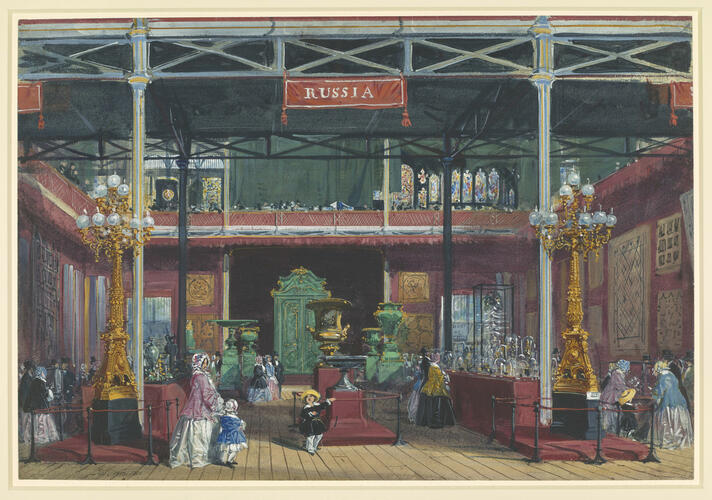
A watercolour view of the Russian stand at the Great Exhibition of 1851. Signed and dated at bottom left: Joseph Nash 1851.
https://www.rct.uk/collection/919954/the-great-exhibition-russia
The Russian Malachite Doors (and the accompanying “Demidoff Malachite”) were one of the most opulent and awe-inspiring displays at the 1851 Great Exhibition.
While Britain and America showcased machines and mass production, the Russian exhibit was a dazzling display of imperial luxury and raw natural resources. The centerpiece of this was a collection of colossal objects made from brilliant green malachite, a semi-precious mineral.
Why They Were a “Wonder”
- Sheer Opulence: The exhibit was dominated by a set of 14-foot-high malachite doors, a gigantic malachite urn, and various other vases and furniture. In an exhibition filled with steel, iron, and steam, this explosion of rich color and polished stone was a breathtaking contrast.
- Visual Spectacle: The vibrant, swirling, deep green of the polished malachite was visually stunning. It drew huge crowds, who saw it as a treasure from a “barbaric” and fabulously wealthy empire.
- A “Sham” of Incredible Skill: The “wonder” was also in the craft. The doors and urns were not carved from solid malachite (which is impossible, as the mineral doesn’t form in such large blocks). They were a masterpiece of veneer. Russian artisans had painstakingly cut thousands of thin malachite slices and, using a “mosaic” technique, fitted them together so perfectly that the swirling patterns matched and the seams were invisible.
This technique, which was a state secret, was almost as impressive as the material itself—it represented an “industrial” process of its own, but one dedicated to pure luxury rather than mass-market utility. The exhibit was a powerful statement of the Russian Empire’s “otherness” and its almost limitless wealth.
London 1851: The Great Exhibition. The Tempest Prognosticator

The Tempest Prognosticator
(Wiki Image Public Domain, https://commons.wikimedia.org/w/index.php?curid=104944967)
This was one of the most eccentric and truly “Victorian” inventions at the Great Exhibition.
The Tempest Prognosticator, also known as the Leech Barometer, was a real, working weather forecasting machine that used live leeches to predict storms.
Dr. George Merryweather of Whitby, England, designed it.
How It Worked (The “Wonder”)
Dr. Merryweather was a firm believer in the folk wisdom that leeches become agitated and restless before a storm. His invention was an elaborate, ornate, and “scientific” way to harness this.
- The Setup: The device was a large, circular, metal stand with 12 small glass jars (bottles) placed around its edge. Each jar contained a single, live leech and a small amount of rainwater.
- The Trigger: Inside each jar, a small piece of whalebone was connected to a wire that ran up to a central bell.
- The “Prognostication”: When a leech sensed an atmospheric change (like a pressure drop), it would instinctively climb to the top of its jar. In doing so, it would push the whalebone trigger, which would ring the bell.
- The Signal: A single ring from one or two leeches might be a false alarm. But if many leeches became agitated and the bell rang frequently, Dr. Merryweather claimed it was a reliable sign of an approaching tempest (storm).
Significance at the Fair
The Tempest Prognosticator was a popular curiosity. It was a perfect blend of natural science, mechanical ingenuity, and showmanship that the Victorian public loved. It wasn’t a major industrial machine like the locomotive, but it was a “wonder” because it represented a serious, if bizarre, attempt to master nature and “prognosticate” (predict) the future.
Dr. Merryweather lobbied for the British government to install his invention at ports and harbors to warn ships of bad weather, but they ultimately favored the less accurate aneroid barometer.
🏛️ London 1851: The Great Exhibition, YouTube Video Links, Views
Here are several YouTube documentaries and visual histories that explore the 1851 Great Exhibition and its revolutionary building, the Crystal Palace.
-
Inside the Crystal Palace: the must-see exhibition of Victorian England
- Channel: Great Exhibition Road Festival
- Views: Over 1,200
- Description: A detailed lecture and visual tour from a V&A Museum curator, showing illustrations and photographs of the exhibition’s most popular and extraordinary works.
-
Virtual Tour of the Great Exhibition
- Channel: The Royal Parks
- Views: Over 31,900
- Description: This 28-minute documentary features a science presenter and a Royal Commission archivist who give a guided walk-through of a virtual 3D recreation of the Crystal Palace.
-
The Inventions Of The 1851 Great Exhibition (That Shook The World)
- Channel: Very Nearly Interesting
- Views: Over 11,700
- Description: This video uses rare photographs and sketches to offer a snapshot of the many inventions and innovations on display at the fair.
🏛️ London 1851: The Great Exhibition. Books
That’s a great request! The Great Exhibition of 1851 generated a massive number of publications, both official records and later historical analyses.
Here are some of the most significant books related to the event, categorized by type:
📜 Contemporary & Primary Source Books
These books were published during or immediately after the Exhibition and serve as primary records of the event.
- Official Descriptive and Illustrated Catalogue of the Great Exhibition of the Works of Industry of All Nations, 1851
- This is the definitive, multi-volume set authorized by the Royal Commission. It details every exhibit, classified by material and country, and includes numerous illustrations.
- A Guide to the Great Exhibition (1851)
- A smaller, single-volume handbook, such as the one published by G. Routledge & Co., was created for visitors, often featuring a map of the Crystal Palace and descriptions of key objects.
- The Art Journal Illustrated Catalogue: The Industry of All Nations, 1851
- A highly regarded, visually rich catalogue that focused on the decorative and fine arts exhibits, offering high-quality engravings.
- Lectures on the Results of the Great Exhibition of 1851 (Published 1852)
- A collection of speeches and essays by prominent figures on the social, artistic, and industrial impacts of the Exhibition.
🏛️ Modern Historical Studies
These scholarly works analyze the Exhibition’s cultural, political, and social significance from a modern perspective.
- The Great Exhibition of 1851: A Nation on Display by Jeffrey A. Auerbach (1999)
- A foundational modern text that explores how the Exhibition was conceived, experienced, and interpreted by different segments of British society, arguing that it served as a platform for national self-discussion.
- The World for a Shilling: How the Great Exhibition of 1851 Shaped a Nation by Michael Leapman (2001)
- A popular history that focuses on the human stories, logistical triumphs, and lasting influence of the event.
- Photography and the 1851 Great Exhibition by Anthony Hamber (2018)
- A specialized study detailing the crucial role the Exhibition played in the public launch and international acceptance of photography as a new art and industry.
🗼 Paris 1889: Exposition Universelle.
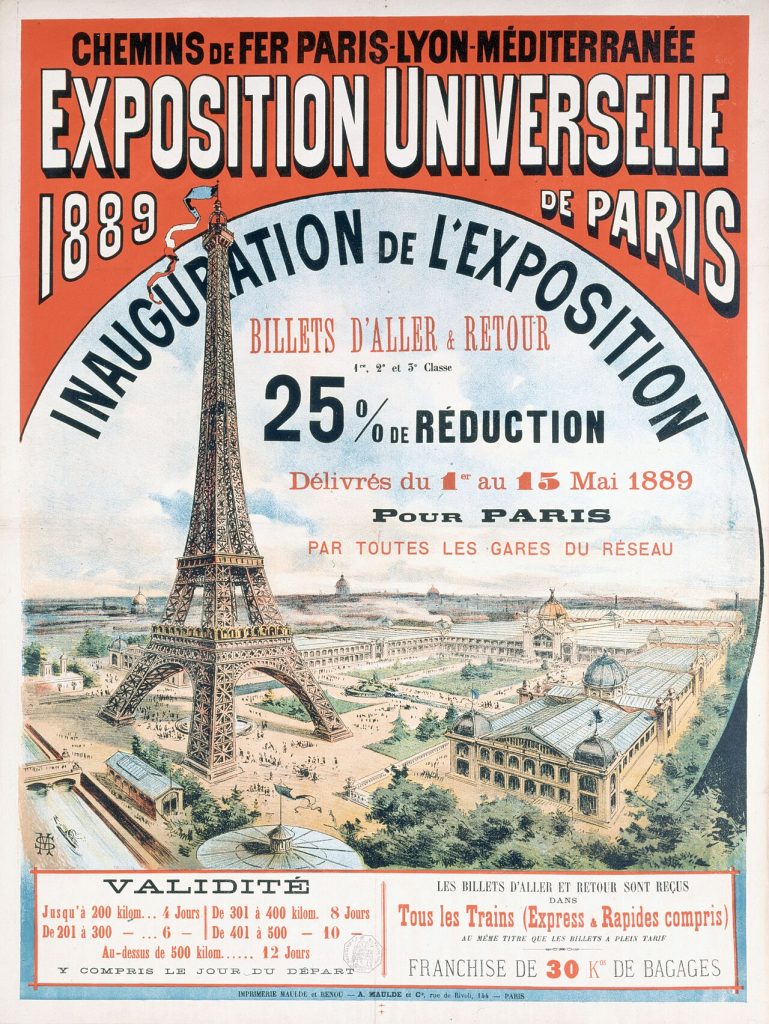
1889 Paris Poster
(Wiki Image By M.S. (monogramme), dessinateur Imprimerie A. Maulde et Cie, imprimeur Unknown author – Musée Carnavalet, Public Domain, https://commons.wikimedia.org/w/index.php?curid=4231834)
🗼 Paris 1889: Exposition Universelle. Quotes
Here are some of the most famous and representative quotes from and about the 1889 Paris Exposition Universelle.
The fair was completely dominated by its new, 300-meter iron tower, which sparked both intense admiration and profound disgust.
🗼 On the Eiffel Tower: The “Protest of the Artists”
Before the fair, a group of France’s most prominent cultural figures, led by Guy de Maupassant and Charles Gounod, published a famous protest letter in the newspaper Le Temps:
“We, writers, painters, sculptors, architects, and passionate devotees of the hitherto untouched beauty of Paris, protest with all our strength, with all our indignation in the name of slighted French taste…
…against the erection… of this useless and monstrous Eiffel Tower… To comprehend what we are arguing, one only needs to imagine for a moment a giddy, ridiculous tower dominating Paris like a gigantic black smokestack, crushing under its barbaric bulk Notre Dame, the Tour Saint-Jacques, the Louvre, the Dome of les Invalides, the Arc de Triomphe, all of our humiliated monuments…”
🗼 Gustave Eiffel’s Defense
Gustave Eiffel, the engineer, defended his tower not as art, but as a monument to science and engineering.
“The Tower will be the tallest edifice ever raised by man. Will it not, therefore, be grandiose in its own way?
…Why should what is admirable in Egypt not be admirable and good in Paris? I seek a reply. I am, I must admit, jealous of my monument… It will be a symbol of the age of iron and the industry in which we live.”
🇺🇸 Thomas Edison’s Praise
The American inventor was a superstar at the fair. He visited the tower and, in the guestbook, wrote a glowing tribute to its creator:
“To M. Eiffel the Engineer, the brave builder of so gigantic and original a specimen of modern engineering, from one who has the greatest respect and admiration for all Engineers, including the Great Engineer, the Bon Dieu [Good God].
— Thomas A. Edison”
😮 A Visitor’s General Impression
A journalist for the San Francisco Chronicle captured the fair’s overwhelming, futuristic atmosphere:
“Night is the best time to see the Exposition. Then the full glory of the electric light, the full beauty of the illuminated fountains, the full weirdness of the shadow-casting tower, and the full gaiety of the streets of all nations are upon the visitor.”
🗣️ On Edison’s Phonograph
The phonograph was the other “must-see” wonder. A contemporary American visitor, Ida M. Tarbell, described the magical effect it had on the crowd:
“The first time I ever heard a phonograph was at the Paris Exposition of 1889… For the first time, I heard a machine which, after a man had talked or sung into it, would repeat what he had said or sung. It was a most amazing, uncanny, and, for a time, a not altogether pleasant experience. It seemed uncanny to hear this thing talk…”
🗼 Paris 1889: Exposition Universelle. History
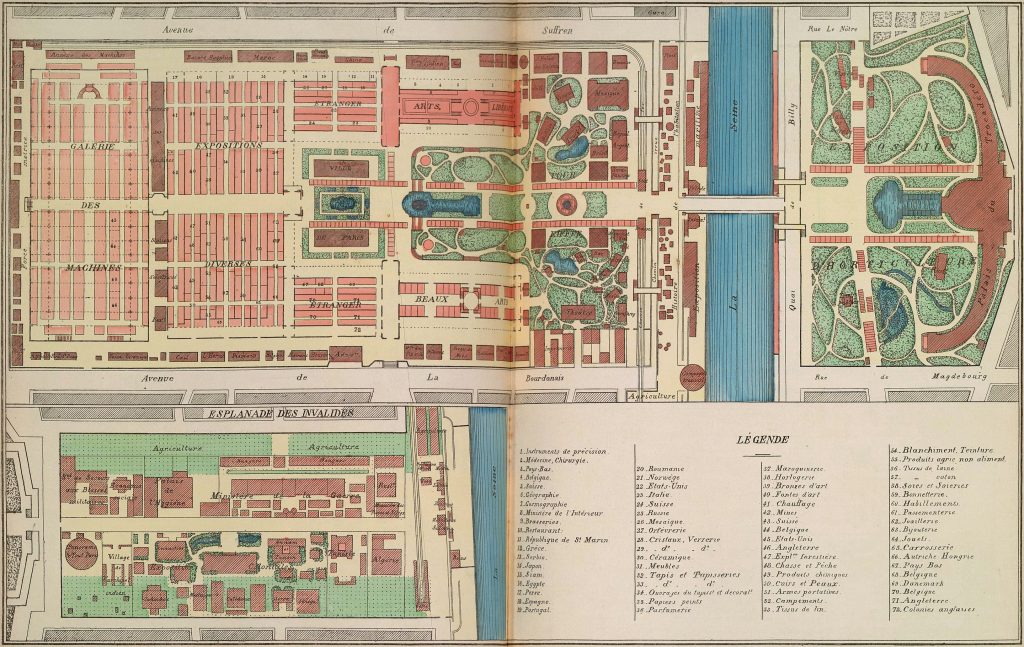
Plan of the Exposition Universelle of 1889
(Wiki Image By This image is available from the Brown University Library under the digital ID 1254153651293933., Public Domain, https://commons.wikimedia.org/w/index.php?curid=24725417)
The 1889 Paris Exposition Universelle, or World’s Fair, was a massive international event held from May 6 to October 31, 1889. It was a spectacular showcase of industrial, scientific, and cultural achievements, designed to prove that France had recovered its power and prestige after its defeat in the Franco-Prussian War and a period of economic recession.
🏛️ Purpose and Significance
The exposition’s primary purpose was to celebrate the 100th anniversary of the French Revolution and the Storming of the Bastille. It was a bold political statement, intended to solidify the international standing of the French Third Republic. By creating a dazzling spectacle of progress, France showcased its industrial might, engineering genius, and the perceived success of its republican government. The fair was a tremendous success, attracting over 32 million visitors and turning a significant profit.
🗼 The Eiffel Tower
The most famous symbol of the fair was its monumental entrance arch: the Eiffel Tower.
- The “Iron Lady”: Designed by engineer Gustave Eiffel, the 300-meter (984-foot) tower was a marvel of wrought-iron engineering.
- A Controversial Star: At the time, it was the world’s tallest man-made structure. Its design was deeply controversial, prompting a group of prominent artists and writers to publish a letter protesting the “useless and monstrous” tower.
- Enduring Icon: Despite the protests, the tower was the fair’s star attraction, proving its engineering and commercial value. It was intended to be temporary, but was saved from being dismantled because it was so valuable as a radiotelegraph station.
⚙️ The Gallery of Machines
While the Eiffel Tower is more famous today, the Galerie des Machines (Gallery of Machines) was considered its architectural equal at the time.
- A Feat of Engineering: This enormous iron-and-glass pavilion was the largest single-span structure in the world, measuring 115 meters (377 feet) wide.
- The “Cathedral of Industry”: Its design, featuring massive three-hinged arches, created a vast, column-free interior.
- Showcase of Technology: Inside, it housed the fair’s industrial and technological exhibits, including Thomas Edison’s new phonographs, demonstrating the power of the new industrial age.
🌍 Other Major Attractions
- Thomas Edison’s Pavilion: The American inventor was a superstar at the fair. His pavilion, which showcased his newly improved phonograph, was a massive draw, allowing visitors to listen to recorded music through listening tubes.
- Illuminated Fountains: The central fountain used new, colored electric lights to create a magical, synchronized display of water and light, symbolizing the new “Age of Electricity.”
- “Human Zoos”: A popular but now deeply controversial part of the fair was the “human zoo” exhibits. The “Rue du Caire” (Cairo Street) was a full-scale reproduction of a street in Cairo, populated by Egyptian artisans, performers, and animals, and presented an exoticized, colonial view of other cultures.
- Buffalo Bill’s Wild West Show: Performing near the fairgrounds, Buffalo Bill Cody and his show, featuring the sharpshooter Annie Oakley, were a massive entertainment hit, introducing a romanticized vision of the American West to Europe.
This video provides a brief historical overview of the 1889 Exposition Universelle. A Look Back at the 1889 Paris Exhibition
🗼 Paris 1889: Exposition Universelle. Eight Wondrous Exhibition
The 1889 Exposition Universelle in Paris was a celebration of the 100th anniversary of the French Revolution and a spectacular showcase of the “Age of Steel and Electricity.”
Its greatest wonder was the entrance arch that towered over the fairgrounds: the Eiffel Tower. At 300 meters (984 feet), it was the tallest man-made structure in the world, a breathtaking feat of engineering that became the enduring symbol of Paris.
Here are eight other wondrous exhibits and attractions from the 1889 Fair.
8 Wondrous Exhibits of the 1889 Exposition Universelle
| Exhibit | Origin | Significance & “Wonder” |
| 1. The Gallery of Machines | France | This was the other great architectural marvel of the fair. A massive iron-and-glass pavilion, it featured the world’s longest column-free arch (377 feet). It housed the fair’s industrial and machinery exhibits, creating a vast, cathedral-like space for technological wonders. |
| 2. Edison’s Phonograph Pavilion | United States | Thomas Edison was a superstar at the fair. His pavilion showcased his new phonograph, a “talking machine” that was pure magic to the public. Visitors lined up for hours to listen to recorded music and speech through individual listening tubes. |
| 3. The “Rue du Caire” (Cairo Street) | Egypt (Colonial Exhibit) | This was one of the most popular and controversial exhibits. It was an elaborate, full-scale reproduction of a street in Cairo, complete with shops, cafes, belly dancers, and 250 donkeys for visitors to ride. It was a key part of the “human zoo” element, presenting an exoticized version of colonial life. |
| 4. Buffalo Bill’s Wild West Show | United States | Though technically performing adjacent to the fair, Buffalo Bill and his show (including Annie Oakley) were the runaway entertainment hit. They performed for massive crowds, introducing Europeans to a romanticized, thrilling vision of the American frontier. |
| 5. The Illuminated Fountains | France | The central fountain was the centerpiece of the nightly spectacles. Using new technology, it was illuminated from within by colored electric lights, creating a magical, changing display of water and light that visitors had never seen before. It was a symbol of the new “City of Light.” |
| 6. The Benz Patent-Motorwagen | Germany | Tucked inside the Gallery of Machines was a revolutionary invention: Karl Benz’s three-wheeled automobile. While it didn’t draw the same crowds as the tower, this was the first time the public was introduced to a commercially available gasoline-powered car. |
| 7. The “History of Habitation” | France | Designed by the architect of the Eiffel Tower’s base, this was a popular and peculiar exhibit. It was a large park featuring 44 full-scale, “authentic” replicas of human houses throughout history, from a caveman’s grotto to an Aztec temple and a Renaissance home. |
| 8. The Internal Decauville Railway | France | The fairgrounds were so massive that a special miniature railway was built to transport visitors. This 60cm gauge train was a wonder in itself, carrying over 6 million people during the exhibition and proving the viability of such light railways for public transport. |
Paris 1889: Exposition Universelle. The Gallery of Machines
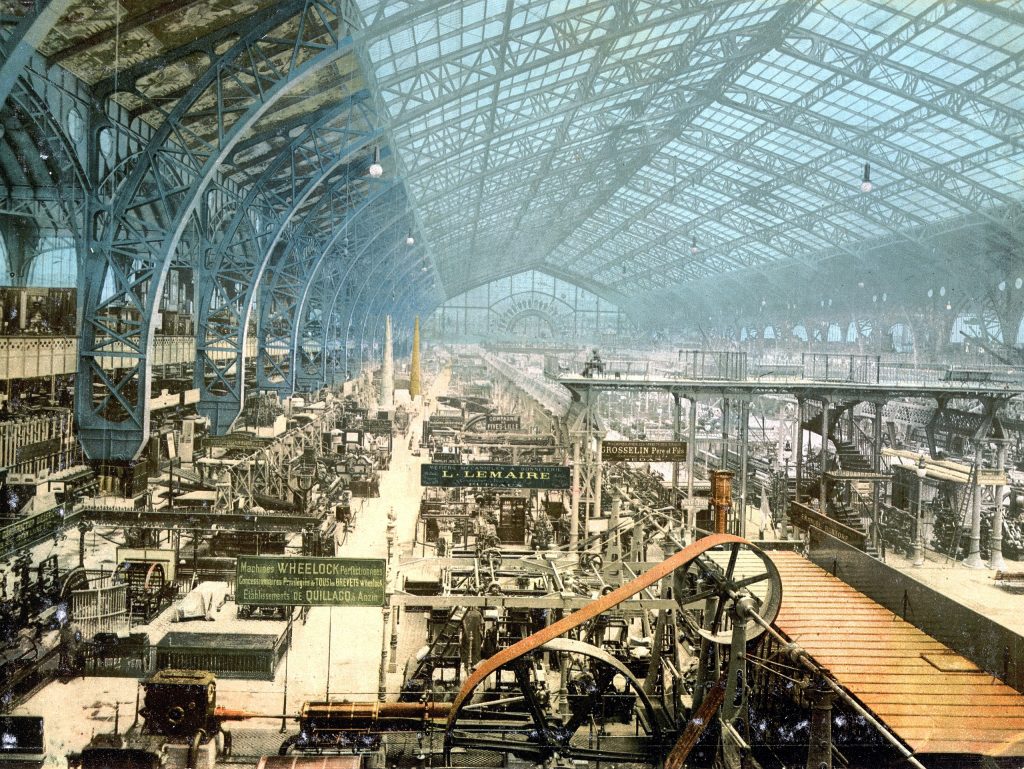
Interior of the Galerie des machines (1889), built by Victor Contamin and Ferdinand Dutert.
(Wiki Image By Library of Congress/original author unknown – This image is available from the United States Library of Congress’s Prints and Photographs division under the digital ID cph. 3g13526.This tag does not indicate the copyright status of the attached work. A normal copyright tag is still required. See Commons:Licensing., Public Domain, https://commons.wikimedia.org/w/index.php?curid=303525)
The Galerie des Machines (Gallery of Machines) was the other primary architectural marvel of the 1889 Exposition Universelle. While the Eiffel Tower was the “wonder” of height, the Gallery of Machines was the “wonder” of space.
It was a colossal iron-and-glass pavilion designed by the architect Ferdinand Dutert and the engineer Victor Contamin to serve as the main industrial exhibit hall.
Why It Was a “Wonder”
- World’s Longest Interior Span: The building’s main hall was 115 meters (377 feet) wide and 420 meters (1,378 feet) long. Its “wonder” was its roof, which was supported by massive, three-hinged trussed arches. This design created the largest, column-free interior space in the world, a breathtaking “cathedral of industry.”
- A Showcase of Industrial Power: The vast hall was filled with the most advanced industrial technology of the day. It was a noisy, dynamic spectacle of machines in motion, including steam engines, dynamos, and manufacturing equipment, all demonstrating the power of the new industrial age.
- Key Inventions: It was here that Thomas Edison showcased his phonograph to astonished crowds. It was also where Karl Benz displayed his Patent-Motorwagen, one of the first commercially available automobiles, introducing the public to the future of transportation.
- The Internal “Ride”: An overhead rolling crane (pont roulant), designed to move heavy machinery, was itself a popular attraction. Visitors could ride on its platform as it traveled the length of the hall, giving them a spectacular elevated view of the exhibits below.
While the Eiffel Tower became the permanent icon, many contemporary critics considered the Gallery of Machines to be the true architectural masterpiece of the Base of the 1889 Fair. It was demolished in 1909.
Paris 1889: Exposition Universelle. Edison’s Phonograph Pavilion
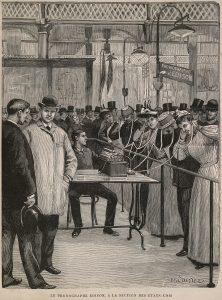
The Edison phonograph was demonstrated at the exposition.
(Wiki Image By Paul Uestel – This image is available from the Brown University Library under the digital ID 1254148461578125., Public Domain, https://commons.wikimedia.org/w/index.php?curid=24702628)
Thomas Edison’s pavilion was one of the absolute superstars of the 1889 Exposition. The main attraction was his recently improved phonograph, a machine that seemed like pure magic to the public.
It was a “talking machine” that could record and play back sound. This was a revolutionary concept, and the exhibit was designed for a massive, personal experience.
Why It Was a “Wonder”
- A Magical Technology: For the first time, people could hear a machine reproduce music and human speech. Edison himself was treated like a wizard, and the phonograph was his greatest marvel.
- The Interactive Experience: The pavilion featured dozens of phonographs. Visitors would wait in long lines for their turn to put a set of individual listening tubes (like a stethoscope) to their ears.
- A Global Showcase: They would listen with astonishment to pre-recorded music, famous speeches, or greetings in different languages. This individual’s personal experience of hearing recorded sound for the first time made it one of the most memorable and popular attractions at the entire fair.
Edison’s exhibit cemented his status as the world’s most famous inventor and was a powerful symbol of American technological ingenuity.
Paris 1889: Exposition Universelle. The “Rue du Caire” (Cairo Street)
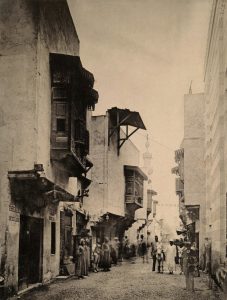
The “Cairo Street”
(Wiki Image By This image is available from the Brown University Library under the digital ID 1254162040163050., Public Domain, https://commons.wikimedia.org/w/index.php?curid=24742615)
The “Rue du Caire” (Cairo Street) was one of the most popular and commercially successful attractions at the 1889 Exposition Universelle.
It was an early and elaborate example of an immersive themed environment. It was not just a display of objects; it was a full-scale, architecturally accurate reproduction of a street in medieval Cairo, designed to transport visitors to an “exotic” new world.
Why It Was a “Wonder”
- Immersive Authenticity: The exhibit was a winding, realistic street lined with shops, cafes, mosques, and houses, all built in a traditional Mamluk architectural style.
- “Human Zoo” Element: The “wonder” (and controversy) was that the street was populated. It featured around 200 people (artisans, merchants, performers) and animals (including 250 donkeys for rides) brought directly from Cairo. Visitors could watch artisans work, buy goods, and interact with people presented as “authentic” inhabitants.
- Introduction of Belly Dancing: The “Rue du Caire” is famously credited with introducing belly dancing (danse du ventre) to the Western public. The performances, seen as scandalous and sensual by Victorian standards, were a massive sensation and a primary reason for the exhibit’s popularity.
While it was a “wonder” of entertainment and immersion for its time, it is also a key example of the 19th-century “human zoo” phenomenon, where colonial subjects and their cultures were put on display as exotic attractions.
Paris 1889: Exposition Universelle. Buffalo Bill’s Wild West Show
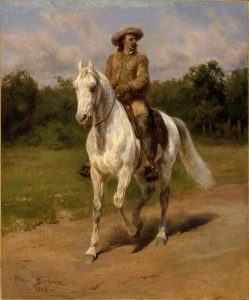
Buffalo Bill Cody, painted in 1889 by Rosa Bonheur
(Wiki Image By Rosa Bonheur – Whitney Gallery of Western Art Collection, Public Domain, https://commons.wikimedia.org/w/index.php?curid=19106540)
While Buffalo Bill’s Wild West Show was not an official exhibit within the 1889 Exposition Universelle, it was set up on a massive 3-acre lot just outside the fairgrounds. It was the runaway entertainment sensation of the event, and for millions of visitors, it was the single most memorable part of their trip.
Why It Was a “Wonder”
- A Spectacle of the “Wild” Frontier: The show was a massive theatrical production, a “living” re-enactment of the American West. It wasn’t a circus; it was presented as a “historical” demonstration of life on the frontier.
- Global Superstars: It starred William F. “Buffalo Bill” Cody himself, an international celebrity, and the legendary sharpshooter Annie Oakley. Oakley became the talk of Paris, amazing crowds by shooting targets while looking in a mirror or hitting a playing card’s edge from 30 paces.
- Massive Scale: This was no small show. It included:
- Over 100 “cowboys” and “vaqueros.”
- Around 100 Native American performers (including Lakota Sioux men and women).
- A herd of buffalo, elk, and wild horses.
- Key “Acts”: The show’s “wonders” were its re-enactments, which included a Pony Express mail-run simulation, a stagecoach being attacked, and spectacular marksmanship from Oakley.
Significance at the Fair
The show’s success was profound. It presented a powerful, romanticized, and thrilling vision of the American frontier that captivated Europe. For many, this show was the American exhibit, eclipsing the official U.S. displays of technology. It cemented the “cowboy” and the “Wild West” as defining parts of American identity in the global imagination.
Paris 1889: Exposition Universelle. The Illuminated Fountains

View of the Eiffel Tower from the Trocadéro Palace. The tower was intended to be a temporary structure serving as an entrance to the exhibit. The buildings represented behind the tower on this engraving are the main galleries of the exhibit (such as the Grande galerie des machines). They were destroyed at the beginning of the twentieth century.
(Wiki Image By Unknown author – This image is available from the Brown University Library under the digital ID 125414492496875., Public Domain, https://commons.wikimedia.org/w/index.php.curid=24356276)
The Illuminated Fountains were one of the most magical and popular nightly attractions of the 1889 Exposition Universelle. They were a centerpiece of the fairgrounds, located on the Champ de Mars, directly between the Eiffel Tower and the Gallery of Machines.
The main display, known as the “Fontaine Monumentale,” was designed by Eugène Vicaire.
Why It Was a “Wonder”
- A Symphony of Light and Water: The “wonder” was the brand-new technology. For the first time on a massive public scale, the fountains were illuminated from within by powerful, high-intensity electric lights.
- “Magic” Color Changes: The real spectacle was the color. The white light from the arc lamps was shone through a revolving series of colored glass filters (red, green, and blue). This allowed operators to “paint” the water in real time, making the water jets change from white to red to blue in a dazzling, pre-choreographed display.
- The “City of Light” Made Real: In an era when electric light was still a novelty, seeing it used so artfully to create a massive, colorful, and dynamic spectacle was pure magic to the visitors. It was a perfect symbol of the fair’s themes of electricity, modernity, and Paris as the “City of Light.”
The illuminated fountain shows were held every night, and the central esplanade would be packed with thousands of visitors who came to watch the “magic” display, which was often timed to music.
Paris 1889: Exposition Universelle. The Benz Patent-Motorwagen

The Benz Patent-Motorwagen Nr. 3 of 1888, used by Bertha Benz for the first long-distance journey by automobile (106 km (66 mi) long)
(Wiki Image by Unknown author – Benz, Carl Friedrich: Lebensfahrt eines deutschen Erfinders. Die Erfindung des Automobils, Erinnerungen eines Achtzigjährigen. Leipzig 1936, S. 155-156. zeno.org, Public Domain, https://commons.wikimedia.org/w/index.php?curid=3180514)
The Benz Patent-Motorwagen (Model III) was a genuinely revolutionary, though somewhat overlooked, exhibit at the 1889 Paris Exposition.
It was a three-wheeled vehicle built by the German inventor Karl Benz. Its “wonder” was not in its size or beauty, but in its revolutionary technology: it was the first gasoline-powered automobile to be commercially available.
Why It Was a “Wonder”
- A “Horseless Carriage”: The vehicle was powered by a small, rear-mounted, single-cylinder internal combustion engine. To a public used to horses, steam, and electricity, this personal, self-propelled “horseless carriage” was a fascinating and bizarre novelty.
- Birth of an Industry: While the fair was dominated by the “Age of Steel” (the Eiffel Tower), this small machine, tucked away in the German section of the Gallery of Machines, represented the dawn of a new era. Benz was not just showing a prototype; he was there to sell his invention and find French business partners.
- Proven Technology: This was the same model that Karl’s wife, Bertha Benz, had famously driven on the world’s first-ever long-distance road trip (106 km) just a year earlier, proving its viability.
While the Patent-Motorwagen didn’t draw the same massive crowds as the Eiffel Tower or Edison’s phonograph, it was a “wonder” in the truest sense: a glimpse of a future that would completely reshape the world.
Paris 1889: Exposition Universelle. The “History of Habitation”

The Roman House and the Gallo-Roman House, by Charles Garnier
(Wiki Image By Fondo Antiguo de la Biblioteca de la Universidad de Sevilla from Sevilla, España – 537049, CC BY 2.0, https://commons.wikimedia.org/w/index.php?curid=51646634)
The “History of Habitation” (L’Histoire de l’Habitation) was one of the most popular and scholarly attractions at the 1889 Exposition. It was an “open-air museum” designed by Charles Garnier, the celebrated architect of the Paris Opera.
This was a serious attempt to create a “scientific” and educational exhibit that was also highly entertaining.
Why It Was a “Wonder”
- A “Walk Through Time”: The exhibit was a park-like area on the Champ de Mars containing 44 full-scale, “authentic” replicas of human dwellings throughout history. Visitors could literally walk from a “prehistoric” cave and a Stone Age hut to an Egyptian villa, an Aztec temple, a Roman house, a medieval manor, and a Renaissance pavilion.
- Designed by a Superstar Architect: The fact that Charles Garnier—the master of the opulent, neo-baroque Opera House—designed it gave the exhibit immense prestige. It was a “wonder” to see such a high-profile artist applying his talents to recreating “primitive” huts and “barbaric” homes.
- Educational Entertainment: It perfectly captured the 19th-century “armchair tourism” and obsession with anthropology. It was a “human zoo” of architecture, allowing visitors to feel as though they were “time-traveling” and understanding the evolution of mankind in a single, pleasant stroll.
The exhibit was an enormous popular success, blending a high-minded scholarly purpose with the novel, picturesque, and “exotic” experience that fairgoers loved.
Paris 1889: Exposition Universelle. The Internal Decauville Railway

Exposition Universelle (1889) Decuville railway
(Wiki Image By Unknown author – This image is available from the United States Library of Congress’s Prints and Photographs division under the digital ID cph.3c01100. This tag does not indicate the copyright status of the attached work. A normal copyright tag is still required. See Commons:Licensing., Public Domain, https://commons.wikimedia.org/w/index.php?curid=3602830)
The Decauville Railway was the internal, narrow-gauge train system that served as the primary mode of transportation inside the massive 1889 Exposition Universelle.
It was not just a utility; it was an attraction in its own right and a “wonder” of modern, light-rail technology.
Why It Was a “Wonder”
- A “Miniature” Mass-Transit System: The fairgrounds were enormous (237 acres). The Decauville railway was a complete, functioning transit network, with 3 kilometers (1.9 miles) of track and multiple stations, designed to move millions of people. The “wonder” was a miniature passenger railway.
- Novel, Flexible Technology: It was a 60cm (2-foot) narrow-gauge line using the “Decauville” system of prefabricated, portable, and easily laid track sections. This was a new, light, and flexible alternative to heavy, permanent rail.
- An Attraction in Itself: The open-sided, “toast-rack” passenger cars were a ride, not just a commute. The line ran along the main avenues, offering spectacular views, and even passed through the Gallery of Machines and the Agricultural pavilion, making the journey part of the exhibition experience.
- Immense Popularity and Success: The railway was a massive hit. It carried over 6.5 million passengers during the fair’s six months, proving its efficiency and popularity. It was a “wonder” because it successfully applied industrial rail technology to public mass transit.
🗼 Paris 1889: Exposition Universelle. YouTube Video Links Views
Here are several YouTube videos that provide historical overviews, documentaries, and visual tours of the 1889 Paris Exposition Universelle.
-
-
- Channel: Busy Baçi
- Views: Over 59,000
- Description: A concise (under 2 minutes) visual tour using restored photographs and 3D models to show the scale of the fairgrounds, including the Gallery of Machines and the Eiffel Tower.
-
-
-
- Channel: Best Documentary
- Views: Over 4.1 million
- Description: This full-length documentary focuses on the construction and history of the Eiffel Tower, the centerpiece of the 1889 Exposition. It details the engineering challenges and the controversy surrounding its creation.
-
Building the Eiffel Tower | Full Documentary | NOVA | PBS (Note: The search result snippet links to a photo montage, but the title “Building the Eiffel Tower” from NOVA PBS, referenced in the snippet, is a high-quality documentary.)
- Channel: NOVA PBS Official (and various re-uploads)
- Views: Over 1.2 million (on one version)
- Description: This documentary explores the engineering and construction of the Eiffel Tower, placing it firmly in the context of the 1889 World’s Fair.
-
-
- Channel: (Channel name not in snippet)
- Views: Not specified, but part of a high-traffic topic.
- Description: This video serves as a detailed guide to the Eiffel Tower, explaining its history and construction, specifically focusing on its role in the World’s Fair.
🗼 Paris 1889: Exposition Universelle. Books
Here are the most essential and well-regarded books on the 1889 Paris Exposition Universelle, ranging from gripping narrative histories to comprehensive illustrated guides.
1. The Definitive Narrative History
“Eiffel’s Tower: The Thrilling Story Behind Paris’s Beloved Monument and the Extraordinary World’s Fair That Introduced It”
- By: Jill Jonnes
- This is widely considered the best modern, narrative history of the fair in English. While the Eiffel Tower is the central character, the book uses it as a lens to tell the full story of the Exposition. It masterfully weaves together the technological marvels (Edison’s phonograph, the Gallery of Machines) with the spectacular entertainment (Buffalo Bill’s Wild West Show) and the intense cultural and artistic debates of the era.
2. The Best Illustrated (Visual) History
“1889 Paris World’s Fair: The Exposition Universelle in Illustrations” (Volumes 1 & 2)
- By: Mark Bussler
- If you want to see the fair as its visitors did, this is the book to get. It’s a meticulously compiled visual record, featuring hundreds of digitally restored engravings, illustrations, and maps from contemporary 1889 publications. It’s the perfect companion to a narrative history, showing you the scale of the fairgrounds, the details of the pavilions, and the tower’s construction.
3. The Best Book for Cultural Context
“Dawn of the Belle Epoque: The Paris of Monet, Zola, Bernhardt, Eiffel, Debussy, Clemenceau, and Their Friends”
- By: Mary McAuliffe
- This book is not about the World’s Fair, but it’s the perfect book to understand the world that created it. It’s a “year-by-year” history of Paris from 1871 to 1900, placing the 1889 Exposition in its proper context, surrounded by the art of the Impressionists, the literature of Émile Zola, and the political scandals of the new French Republic.
4. Original (Primary Source) Exhibition Catalog
“1889: La Tour Eiffel et l’Exposition universelle”
- By: Musée d’Orsay
- This is the official catalog from the 1989 centennial exhibition at the Musée d’Orsay. It is a French-language book but is an invaluable, scholarly resource filled with original photographs, architectural plans, and essays on the fair’s art, design, and cultural impact, including in-depth looks at the colonial exhibits and the Gallery of Machines.
🎡 Chicago 1893: World’s Columbian Exposition.
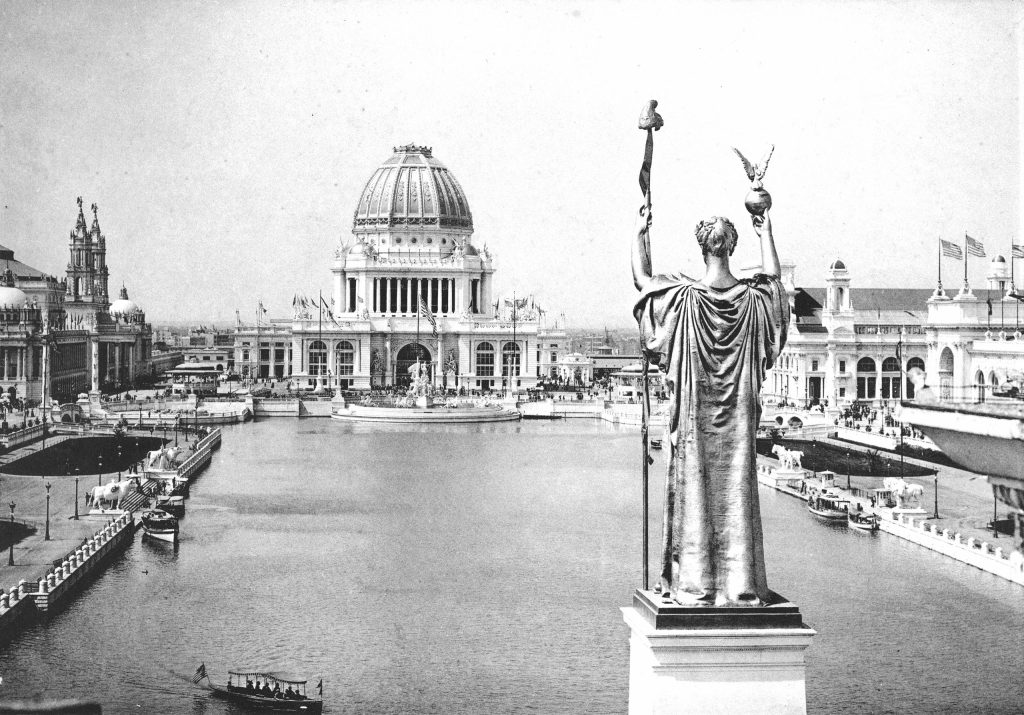
Looking West From Peristyle, Court of Honor and Grand Basin of the 1893 World’s Columbian Exposition (Chicago, Illinois)
(Wiki Image By C. D. Arnold (1844-1927); H. D. Higinbotham – The Project Gutenberg EBook of Official Views Of The World’s Columbian Exposition, Public Domain, https://commons.wikimedia.org/w/index.php?curid=50469469)
🎡 Chicago 1893: World’s Columbian Exposition. Quotes
Here are some of the most famous and representative quotes from and about the 1893 World’s Columbian Exposition in Chicago, capturing its sense of awe, its cultural impact, and its complex legacy.
🏛️ The Fair’s Ambitious Vision
This quote, though perhaps spoken by architect Daniel Burnham after the fair, has become its unofficial motto and perfectly captures the audacious spirit of its creators:
“Make no little plans; they have no magic to stir men’s blood and probably themselves will not be realized. Make big plans; aim high in hope and work, remembering that a noble, logical diagram once recorded will never die, but long after we are gone will be a living thing, asserting itself with ever-growing insistency.”
A contemporary journalist, Walter Besant, expressed the utopian, almost dream-like quality of the “White City”:
“This is not a City for a single summer: it is a City which should belong to the world… It is the dream of a poet, a vision of some celestial city.”
😮 The Shock of the New: Technology & Culture
The fair was a turning point for many visitors, who saw a new world of technology and ideas opening before them.
The historian Henry Adams wrote of the intellectual and technological shock he felt at the fair, contrasting the classical “White City” with the powerful, new machinery:
“Chicago was the first expression of American thought as a unity; one must start there… One sat down to ponder on the steps of Richard Hunt’s Administration Building and gazed at the Court of Honor… Chicago was colossal.”
The fair’s most popular attractions were the Ferris Wheel and the chaotic Midway. A popular ditty of the day, famously referenced by a visitor, showed how the exotic Midway overshadowed the high-minded exhibits:
“After the fair, I’m goin’ back to the farm… For I’ve seen the streets of Cairo, I’ve seen the big Ferris wheel, and I’ve seen the Trocadero, but I’ve not seen the Art quadrille. Oh, I’m sad and sick and sorry that I’ve got to go to plow, But I’m goin’ to tell the people that I’ve seen the Midway anyhow!”
✨ A Pivotal Moment for America
The fair introduced many Americans to new foods, products, and ideas, as summed up by the historian Reid Badger:
“For the visitor, the Chicago World’s Fair of 1893 was a short course in the history of civilization and a glance at the Utopian future, all for 50 cents. Visitors… were introduced to the Ferris wheel, the zipper, Cracker Jack, shredded wheat, juicy fruit gum, and… electric lights.”
🌍 A New Global Stage
The Parliament of the World’s Religions at the fair was a landmark event. The Hindu monk Swami Vivekananda made a powerful, star-making debut in the West with his opening words:
“Sisters and Brothers of America… I am proud to belong to a religion that has taught the world both tolerance and universal acceptance. We believe not only in universal toleration, but we accept all religions as true.”
📖 The Modern Perspective: The Devil in the White City
Erik Larson’s 2003 bestselling book captured the fair’s magic and darkness for a new generation. He described the profound effect of the fair’s electric illumination:
“When visitors came to the Court of Honor… they saw a dream of perfect beauty, a city of white palaces… At night, the transformation was even more compelling. The fair alone, among all the places in the world, was completely illuminated by electricity. It was a wonderland.”
🎡 Chicago 1893: World’s Columbian Exposition. History

Bird’s Eye View, 1893
(Wiki Image By Rand McNally and Company – Library of Congress, Public Domain, https://commons.wikimedia.org/w/index.php?curid=50474238)
Here is the history of the 1893 World’s Columbian Exposition in Chicago.
🏛️ The “White City”
The World’s Columbian Exposition was a massive and profoundly influential World’s Fair held in Chicago in 1893. While officially celebrating the 400th anniversary of Christopher Columbus’s arrival in the New World (it opened a year late), its real purpose was to prove that Chicago—and by extension, the United States—had “arrived” as a cultural and industrial equal to the great cities of Europe, especially its direct rival, the 1889 Paris Fair.
🏙️ The Vision: A Utopian City
Directed by architect Daniel Burnham with a landscape designed by Frederick Law Olmsted, the fair’s main campus was a stunning spectacle known as the “White City.”
- Architecture: Burnham brought together the nation’s top architects (like Louis Sullivan) to design a unified, harmonious, and monumental campus. They chose a neoclassical (or “Beaux-Arts”) style, and nearly all the buildings were covered in white stucco, giving the fairgrounds a gleaming, dream-like appearance.
- The “City Beautiful” Movement: This vision of a clean, grand, and orderly city was so influential that it launched the “City Beautiful” movement, which would shape American city planning and public architecture for decades.
⚡ The “War of the Currents”
The fair was the first all-electric fair, and it became the main battleground for the “War of the Currents.”
- Thomas Edison (DC): He bid to illuminate the fair with his direct current (DC) system.
- Westinghouse & Tesla (AC): George Westinghouse, using Nikola Tesla’s alternating current (AC) patents, dramatically underbid Edison.
- The Result: Westinghouse won the contract. The “White City” became the “City of Light,” the largest demonstration of electric illumination the world had ever seen. Its dazzling success proved the superiority of AC for large-scale power distribution, effectively ending the “war.”
🎡 The Midway Plaisance & The Ferris Wheel
In contrast to the high-minded, classical “White City,” a mile-long strip called the Midway Plaisance served as the fair’s entertainment and amusement zone.
- The Ferris Wheel: This was the star of the Midway and America’s answer to the Eiffel Tower. Designed by George W. G. Ferris, it was a 264-foot-tall rotating steel wheel, a mechanical marvel that carried over 2,000 passengers at a time.
- “Exotic” Exhibits: The Midway featured “human zoo” exhibits, including the hugely popular “Street in Cairo,” which famously introduced belly dancing to a shocked and fascinated American public.
📖 Lasting Impact and Innovations
The fair was a massive success, attracting 27 million visitors. Its influence on American culture was profound:
- New Products: It introduced the public to Cracker Jack, Juicy Fruit gum, Shredded Wheat, and the zipper.
- Cultural Milestones: The Pledge of Allegiance was written for the event. The Parliament of the World’s Religions, held in conjunction with the fair, was the first formal gathering of Eastern and Western spiritual leaders, famously introducing Swami Vivekananda and Hinduism to America.
🔥 A Darker Side and Tragic End
- Exclusion: The fair was criticized by activists like Ida B. Wells for its racist and exclusionary portrayal of African Americans.
- H. H. Holmes: The fair’s chaotic atmosphere was famously exploited by America’s first serial killer, H. H. Holmes, who built a “Murder Castle” hotel to lure and kill visitors.
- The Fire: The “White City” was a temporary dream. Its buildings were not made of marble but of a temporary material called “staff.” Shortly after the fair closed, a massive fire swept through Jackson Park, destroying most of the “White City” and leaving its “heavenly” vision in blackened ruins.
This video from PBS’s American Experience provides an excellent overview of the fair and its cultural impact. The World’s Columbian Exposition of 1893
🎡 Chicago 1893: World’s Columbian Exposition. Frederick Law Olmsted
Olmsted in 1893; engraving after a photograph.
(Wiki Image By James Notman, Boston; engraving of image later published in Century Magazine (source) – The World’s Work, 1903: https://archive.org/stream/worldswork06gard#page/3938/mode/2up, Public Domain, https://commons.wikimedia.org/w/index.php?curid=26824311)
To Frederick Law Olmsted, the 1893 World’s Columbian Exposition was not just a fair; it was a battle for the soul of the American city. While architect Daniel Burnham built the “White City”—a neoclassical utopia of plaster and electric light—Olmsted was tasked with creating the earth beneath it.
Already famous for Central Park, the 71-year-old Olmsted viewed the Chicago fair as his final great commission. His contribution was the landscape of the exposition, a foundational masterpiece that required terraforming a swamp into a Venice-like system of lagoons and islands.
1. The Challenge: “A Dreary Morass”
When the fair’s directors asked Olmsted to pick a site, he bypassed the drier, inland options and pointed to Jackson Park on the shores of Lake Michigan. At the time, it was a desolate, waterlogged swamp that one observer called a “dreary morass.”
Olmsted chose it because of the water. His vision was to dredge the swamp, using the excavated soil to build up solid terraces for the massive buildings. At the same time, the remaining channels would become a cooling, circulating system of lagoons connecting the fair to the Great Lake.
2. The Design: The “Quieting Influence”
Olmsted knew the fair’s architecture would be overwhelming—massive, bright, crowded, and loud. He believed visitors would need a psychological antidote to this “artificial grandeur.” His goal was to provide a subconscious sense of peace amidst the chaos.
- The Lagoons: Instead of formal reflecting pools, he designed winding, naturalistic waterways lined with cattails, willows, and aquatic plants. He wanted the water to look mysterious and ancient, not engineered.
- The Wooded Island: At the center of the lagoons, Olmsted created a 15-acre sanctuary called the Wooded Island. He fought fiercely to keep this land free of structures, intending it to be a place where people could escape the exhibits.
- The Compromise: He eventually lost a minor battle to keep it empty; the Ho-o-den (Phoenix Hall), the Japanese government’s pavilion, was built there. However, its subtle, organic architecture fit Olmsted’s aesthetic so well that he eventually accepted it.
3. The Execution: A Race Against Time
The scale of the engineering was unprecedented. Olmsted’s team, led by his protégé Henry Codman (who tragically died during the project), had to coordinate the dredging of millions of cubic yards of wet sand and soil in less than two years.
- The “Invisible” Work: While the public marveled at the white buildings, few realized that the ground they walked on was an artificial crust created by Olmsted. He imported thousands of railcars of rich soil to cover the sand so that trees and shrubs would grow instantly, giving the illusion of an established landscape.
4. The Human Cost
The project broke him. The relentless deadline, the death of his partner Codman, and the sheer physical demand of the site took a severe toll on the aging Olmsted. By the time the fair opened in May 1893, his mental health was rapidly deteriorating. The exposition is often considered the closing chapter of his career; he was institutionalized at McLean Hospital (whose grounds he had also designed) shortly after the fair’s conclusion.
Summary of Olmsted’s Contribution
| Feature | Purpose | Legacy |
| The Lagoons | To link the fair to Lake Michigan and provide boat transport (gondolas). | Still a central feature of Jackson Park today. |
| The Wooded Island | A “quieting influence” to counter the bustle of the crowds. | It remains as the “Wooded Island,” now home to the Osaka Garden. |
| The Midway Plaisance | A linear park connecting Jackson and Washington Parks became the entertainment strip. | The term “Midway” is now synonymous with fairground entertainment. |
“The fundamental importance of the work… is to establish a considerable extent of broad and apparently natural scenery, in contemplation of which a degree of quieting influence will be had.”
— Frederick Law Olmsted
🎡 Chicago 1893: World’s Columbian Exposition. Eight Wondrous Exhibition
The 1893 World’s Columbian Exposition in Chicago was a monumental event, a grand celebration of the 400th anniversary of Christopher Columbus’s arrival in the New World. It was a pivotal moment for America, showcasing its emergence as a global industrial and cultural power.
The greatest wonder was the fair itself: The “White City.” This was a massive, dream-like city built in the neoclassical style, with gleaming white stucco buildings, grand lagoons, and electric streetlights, creating a unified, utopian vision that profoundly influenced American architecture.
Here are eight other wondrous exhibits and attractions from the 1893 Fair.
8 Wondrous Exhibits of the 1893 Columbian Exposition
| Exhibit | Origin | Significance & “Wonder” |
| 1. The Ferris Wheel | United States | This was the star of the show and Chicago’s answer to the Eiffel Tower. Designed by George W. G. Ferris, it was a 264-foot-tall rotating steel wheel. It carried 36 cars, each holding 60 people, offering a breathtaking, 20-minute ride over the fairgrounds. |
| 2. Westinghouse’s AC Power | United States | This exhibit was a victory in the “War of the Currents.” Westinghouse and Nikola Tesla underbid Thomas Edison to illuminate the fair using their alternating current (AC) system. The result was the “City of Light”—the most spectacular display of electric illumination the world had ever seen, proving AC’s dominance for large-scale power. |
| 3. The Midway Plaisance | International | This was the fair’s mile-long entertainment “strip,” separate from the main “White City.” It was a chaotic, noisy, and immensely popular area featuring rides, shows, and “anthropological” villages. It was the “low-brow” entertainment to the “high-brow” culture of the central court. |
| 4. The “Illinois” Battleship | United States (Exhibit) | A full-scale, realistic replica of a new U.S. Navy battleship. It was not a real ship but a brick-and-plaster building built on pilings in Lake Michigan, complete with sailors, guns, and machinery. It was a massive symbol of America’s new naval power. |
| 5. The Woman’s Building | United States | A landmark in the history of women’s rights. Designed by architect Sophia Hayden and managed by Bertha Palmer, this building showcased the achievements of women in art, science, and industry from around the world. It was a “fair within a fair,” organized and run entirely by women. |
| 6. The Manufactures & Liberal Arts Building | United States | A wonder of sheer scale. At the time, this was the largest building in the world, covering over 30 acres. It was a massive iron, steel, and glass structure so vast that the U.S. Capitol building could fit inside its central hall. It housed exhibits from hundreds of companies. |
| 7. The “Moving Walkway” | United States | A brand-new form of transportation. This was a moving electric sidewalk—the first of its kind—that transported visitors down a long pier. It had a slow walking section and a faster section with seats —a novelty that amazed fairgoers. |
| 8. The “Viking Ship” | Norway | An authentic wonder of historical replication. A Norwegian crew built a full-scale replica of the 9th-century Gokstad Viking ship and sailed it from Norway across the Atlantic and through the Great Lakes to Chicago. It was a stunning feat of navigation and historical scholarship. |
Chicago 1893: World’s Columbian Exposition. The Ferris Wheel
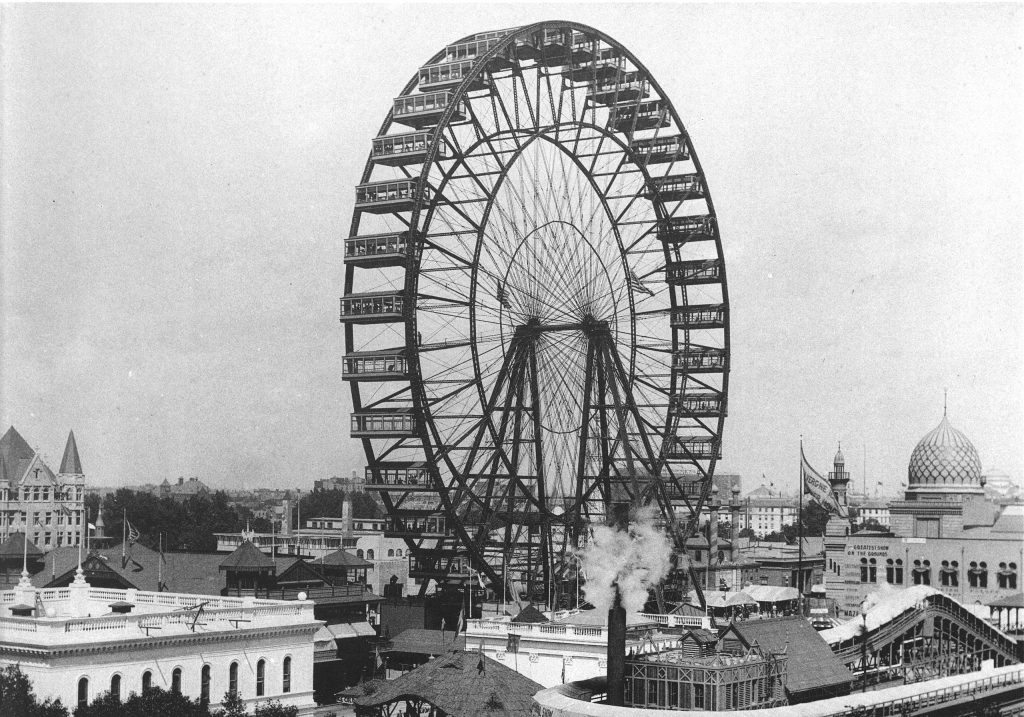
(Wiki Image By C. D. Arnold (1844-1927); H. D. Higinbotham – The Project Gutenberg EBook of Official Views Of The World’s Columbian Exposition – site file, Public Domain, https://commons.wikimedia.org/w/index.php?curid=52042830)
The Ferris Wheel was the undisputed icon of the 1893 World’s Columbian Exposition and America’s defiant, massively successful answer to the 1889 Eiffel Tower in Paris.
The fair’s director, Daniel Burnham, had challenged America’s engineers to “out-Eiffel Eiffel.” The winner was a daring proposal from a young Pittsburgh bridge-builder named George Washington Gale Ferris Jr.
Why It Was a “Wonder”
- A Monument of Steel: It was a 264-foot-tall rotating wheel, the largest of its kind ever imagined. Unlike smaller pleasure wheels, this was a colossal feat of structural engineering.
- Revolutionary Design: The “wonder” was its engineering. It was not a compression wheel (like a wagon wheel) but a tension wheel, built on the same principle as a modern bicycle wheel. The axle was massive (the largest single piece of forged steel in the world at the time), but the wheel itself was held together by a web of thin, taut steel rods, making it seem impossibly light for its size.
- Massive Scale: The wheel carried 36 cars. Each car was the size of a Pullman railway car and could hold 60 people. This gave the wheel a staggering total capacity of 2,160 passengers at a time.
- The Experience: The ride cost 50 cents—the same price as a full-day’s admission to the fair—and lasted 20 minutes. It made two complete revolutions: one to load and unload the cars, and a second, continuous nine-minute rotation. From the top, passengers had a breathtaking, panoramic view of the “White City,” Lake Michigan, and the city of Chicago.
The Ferris Wheel was the star of the Midway Plaisance and a substantial financial success, carrying over 1.4 million riders. It single-handedly legitimized the idea of the “amusement park” and gave its name to every ride of its kind that followed.
Chicago 1893: World’s Columbian Exposition. Westinghouse’s AC Power

Westinghouse’s World’s Fair presentation explaining Tesla‘s AC induction motors and high-frequency experiments
(Wiki Image By Unknown author – https://historicpittsburgh.org/islandora/object/pitt%3A20170320-hpichswp-0001 Historic Pittsburgh Historic Pittsburgh / historicpittsburgh.org / Nikola Tesla’s personal exhibit at the 1893 World’s Fair, Public Domain, https://commons.wikimedia.org/w/index.php?curid=88994427)
This was the exhibit that won the “War of the Currents” and electrified the “White City,” turning it into the “City of Light.”
The “wonder” of the Westinghouse exhibit was not a single object but the entire power and lighting system of the fair itself.
The “War” and the Contract
The fair was the final battleground for the “War of the Currents” between two industrial titans:
- Thomas Edison (DC): He insisted on using his low-voltage Direct Current (DC) system, which was inefficient over long distances and would have been incredibly expensive.
- George Westinghouse (AC): He championed the high-voltage Alternating Current (AC) system, developed with Nikola Tesla’s patents.
Westinghouse dramatically underbid Edison (by about 70%) and won the exclusive contract to light the fair.
Why It Was a “Wonder”
- Unprecedented Scale: Westinghouse installed a massive power plant with a dozen 1,000-horsepower AC generators. It was the largest electrical project in human history, powering hundreds of thousands of light bulbs and the fair’s electric motors.
- The “City of Light”: The result was the greatest spectacle of artificial illumination the world had ever seen. The “White City’s” classical buildings, fountains, and lagoons were bathed in a brilliant, uniform glow. For millions of visitors who still lived by gaslight, seeing a whole city illuminated at night was a magical, utopian vision of the future.
- Technological Triumph: The exhibit was a dazzling showcase of Nikola Tesla’s polyphase AC system. It proved, on a massive scale, that AC was safe, reliable, and far superior to DC for distributing power over a wide area.
The overwhelming success of the AC-powered “City of Light” was a public relations triumph. It effectively ended the “War of the Currents” and established AC as the dominant standard for electrical power, a status it retains to this day.
Chicago 1893: World’s Columbian Exposition. The Midway Plaisance
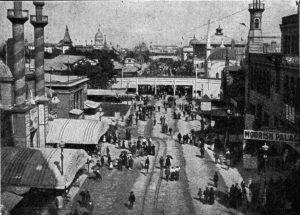
Midway Plaisance
(Wiki Image By E. Benjamin Andrews – Andrews, E. Benjamin. History of the United States, volume V. Charles Scribner’s Sons, New York. 1912., Public Domain, https://commons.wikimedia.org/w/index.php?curid=1718770)
The Midway Plaisance was the massive, mile-long entertainment and amusement strip of the 1893 World’s Columbian Exposition. It was deliberately separated from the main fairgrounds, the grand and orderly “White City.”
If the White City was the “high-brow” part of the fair—a classical, clean, and educational utopia—the Midway was its chaotic, noisy, “low-brow” counterpart. It was the commercial, profit-driven zone for pure entertainment, and it’s where most of the fun was.
Key “Wonders” of the Midway
The Midway was a sensation, a mix of early amusement park rides, cultural exhibits, and “human zoos.”
- The Ferris Wheel: The main attraction and icon of the Midway. Designed by George W. G. Ferris, it was a 264-foot-tall steel marvel built to rival the Eiffel Tower. It dominated the skyline and was the must-do ride of the fair.
- The “Street in Cairo”: This was the most popular and profitable concession. It was an immersive, sprawling recreation of a Cairo street, complete with shops, cafes, and donkeys. It famously introduced belly dancing to a shocked and enthralled American public.
- The “Ethnographic” Villages: The Midway was lined with “authentic” villages from around the world, such as a “German Village,” “Javanese Village,” and “Irish Village.” These were a blend of education, entertainment, and “human zoo,” where visitors could see people from other cultures (often in costume) performing and living.
- The Captive Balloon Ride: One of the most thrilling rides, this was a massive tethered gas balloon that would take passengers 1,500 feet into the air, offering an even higher view than the Ferris Wheel.
Significance
The Midway Plaisance was a massive financial success and arguably more popular than the White City’s educational exhibits. It was the first time that rides, food, cultural exhibits, and “exotic” shows were all brought together in one entertainment strip.
In doing so, it created the original blueprint for the modern American amusement park.
Chicago 1893: World’s Columbian Exposition. The “Illinois” Battleship

Postcard from the Columbian Exhibition of the Battleship Illinois
(Wiki Image By American Lithographic Company, New York. 1893 – http://www.chicagopostcardmuseum.org/19th_century_rotunda_1893_worlds_columbian_exposition.html, Public Domain, https://commons.wikimedia.org/w/index.php?curid=31222257)
The U.S. Battleship “Illinois” was one of the most popular and impressive “wonders” of the 1893 World’s Fair. It was not a real, floating warship but a full-scale, 1:1 replica of an Indiana-class coastal defense battleship.
It was a brilliant piece of propaganda and a marvel of exhibition design.
Why It Was a “Wonder”
- A Symbol of Power: The 348-foot-long “Illinois” was a massive, tangible symbol of America’s “New Steel Navy” and its emergence as a global military power. For millions of visitors from the landlocked Midwest, it was their first and only chance to see a modern battleship.
- Realistic Construction: It was not a real ship but a building designed to look like one. It was built on pilings in Lake Michigan, with a brick-and-timber frame covered in plaster and “staff” (the same material used for the “White City”) to simulate steel armor plates perfectly.
- “Authentic” Experience: The exhibit was “manned” by active-duty U.S. Navy sailors and marines. It was fully equipped with real, modern naval guns (including 13-inch cannons), torpedoes, and all the machinery and fittings of a genuine warship, making it an immersive experience for visitors.
Chicago 1893: World’s Columbian Exposition. The Woman’s Building
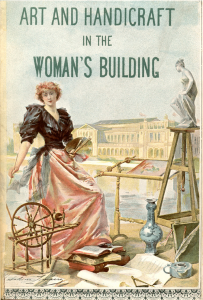
Woman’s Building Lemaire poster
(Wiki Image By Madeleine Lemaire – University of Radford Digital Library, Public Domain, https://commons.wikimedia.org/w/index.php?curid=47638494)
The Woman’s Building was a landmark exhibit at the 1893 World’s Columbian Exposition. It was a “wonder” because it was the first central fair pavilion entirely dedicated to showcasing the achievements of women, and it was almost wholly managed, designed, and decorated by women.
Significance & Design
- Managed by Women: The entire project was overseen by the “Board of Lady Managers,” an influential group led by the Chicago socialite Bertha Palmer. This board successfully lobbied for the creation, funding, and control of the building.
- Designed by a Woman: The board held a national competition for a female architect to design the building. The winner was Sophia Hayden, a 21-year-old from Boston and the first woman to graduate from MIT’s four-year architecture program. Her design was an elegant, classical building in the Italian Renaissance style.
What Was Inside?
The building’s purpose was to prove that women were contributing to all fields of modern life. It was a “fair within a fair,” containing:
- Art: A main gallery featured 600 works by women from around the world, including Mary Cassatt.
- Literature: A grand library held 7,000 books, all written by women.
- Innovation: Exhibits showcased women’s achievements in science (the “Women’s Laboratory”), invention (displaying patents filed by women), music, and education.
- Murals: The building’s main hall (the “Hall of Honor”) featured two massive murals:
- “Modern Woman” by Mary Cassatt.
- “Primitive Woman” by Mary Fairchild MacMonnies.
The Women’s Building was a pivotal, if temporary, institution in the history of women’s rights, providing a robust, visible platform for female achievement and capability on a global stage.
Chicago 1893: World’s Columbian Exposition. The Manufactures & Liberal Arts Building
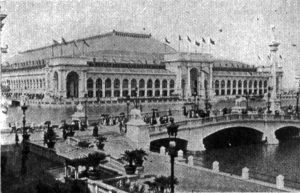
The Manufactures and Liberal Arts Building, seen from the southwest.
(Wiki Image By E. Benjamin Andrews – Andrews, E. Benjamin. History of the United States, volume V. Charles Scribner’s Sons, New York. 1912., Public Domain, https://commons.wikimedia.org/w/index.php?curid=1718717)
The Manufactures and Liberal Arts Building was the central and most significant building at the 1893 World’s Columbian Exposition.
Its “wonder” was its colossal, unprecedented scale.
At the time, it was the largest building in the world. It was a gigantic structure of iron, steel, and glass, designed by architect George B. Post.
Why It Was a “Wonder”
- Immense Size: The building covered over 30 acres of land (some sources say up to 44 acres, including its annexes). It was so vast that it could have comfortably held the U.S. Capitol, the Great Pyramid of Giza, and St. Paul’s Cathedral all at once.
- Structural Marvel: Its central hall featured a massive, column-free, arched nave supported by steel trusses. This created an enormous, wide-open interior space (385 feet wide and 212 feet high) that was a breathtaking engineering feat, similar in scale to the 1889 Gallery of Machines in Paris.
- A “City of Goods”: Inside this one building was a “world” of exhibits. It housed the consumer goods, industrial products, and artistic creations (the “liberal arts”) from nearly every country participating in the fair. Visitors could spend an entire day just walking its miles of aisles.
The building was the primary symbol of the fair’s theme: the massive scale of global manufacturing and the power of American industry to build on a grand, almost unbelievable, level.
Chicago 1893: World’s Columbian Exposition. The “Moving Walkway”
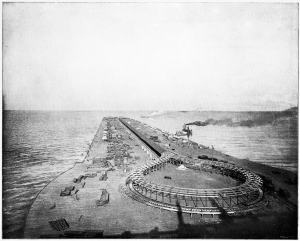
The Great Wharf, Moving Sidewalk
(Wiki Image By This image is from the book “History of the World’s Fair” by Benjamin Cummings Truman and published by the Mammoth Publishing Company in 1893, and is a public domain image within the United States., Public Domain, https://commons.wikimedia.org/w/index.php?curid=16079714)
This was a brand-new invention, and the first-ever moving walkway (or “Movable Sidewalk”) to be seen by the public. It was a “wonder” not just as a ride, but as a practical, high-capacity, futuristic form of mass transit.
It was designed by architect Joseph Lyman Silsbee. It ran for over 2,500 feet along a long pier that extended into Lake Michigan, carrying visitors who arrived by steamboat to the main fairgrounds.
Why It Was a “Wonder”
- It was a Novelty: For a 5-cent fare, visitors could “ride as long as they wish.” This made it a popular attraction in its own right, offering a cool breeze off the lake and a “superb” panoramic view of the White City’s skyline.
- A New Form of Transit: Unlike modern airport walkways, this was a massive, dual-platform system that ran in a loop.
- One platform was for standing and moved slowly (approx. 2-3 mph).
- A second, parallel platform was for sitting—it was equipped with benches and moved at a faster speed (approx. 4-6 mph).
- High Capacity: It was an engineering marvel that could transport over 31,000 people per hour, demonstrating a new potential for urban mass transit.
The Moving Sidewalk was a considerable success but short-lived. It was destroyed in a massive fire in January 1894, just months after the fair closed.
This video delves into the history of this “Forgotten Moving Sidewalk” from the 1893 World’s Fair. Chicago’s Forgotten Moving Sidewalk
Chicago 1893: World’s Columbian Exposition. The “Viking Ship”

Viking, a replica of the Gokstad ship.
(Wiki Image Public Domain, https://commons.wikimedia.org/w/index.php?curid=338013)
This exhibit was a true “wonder” because it wasn’t a model or a simulation; it was a full-scale, seaworthy replica of a 9th-century Viking longship that sailed from Norway to Chicago.
The ship was named the “Viking” and was an exact copy of the Gokstad ship, a famous Viking-era vessel excavated in Norway in 1880.
Why It Was a “Wonder”
- A Feat of Experimental Archaeology: A Norwegian crew, led by Captain Magnus Andersen, built the ship using the same methods and tools as the original Vikings.
- An Incredible Journey: The crew then sailed the “Viking” across the Atlantic Ocean—from Bergen, Norway, to Newfoundland, then through the St. Lawrence Seaway and the Great Lakes, arriving in Chicago to massive crowds.
- Proven Seaworthiness: The voyage was a stunning act of seamanship that demonstrated, for the first time in the modern era, that Viking ships were fully capable of making long, dangerous, open-ocean voyages. It gave immense credibility to the idea that Vikings had reached North America centuries before Columbus.
- “Authentic” History: In a fair full of plaster-and-stucco replicas (the “White City”), the “Viking” was a piece of rugged, authentic, and living history that had just completed its own heroic journey.
🎡 Chicago 1893: World’s Columbian Exposition. YouTube Video Links Views
Here are several YouTube documentaries and videos covering the 1893 World’s Columbian Exposition in Chicago.
-
-
- Channel: Extreme Mysteries
- Views: Over 1.7 million
- Description: This is the most famous and comprehensive documentary on the 1893 World’s Fair. The nearly 2-hour film, narrated by Gene Wilder, covers the fair’s construction, its most famous attractions, the “War of the Currents” between Tesla and Edison, and the dark, parallel story of serial killer H.H. Holmes.
-
-
-
- Channel: Grunge
- Views: Over 565,000
- Description: A shorter, 11-minute documentary that covers the fair’s triumphs and its darker side, including the exclusion of African Americans, the exhibition of Indigenous peoples, and its connection to H.H. Holmes.
-
-
-
Channel: Geeky Philosopher
- Views: Over 14,000
- Description: This video essay explores the “Devil in the White City” narrative, focusing on the parallel stories of the fair’s architect, Daniel Burnham, and the serial killer H.H. Holmes, who used the fair to hunt his victims.
-
This video, narrated by Gene Wilder, is a feature-length film that provides a detailed and engaging look at the “White City” and its history.
🎡 Chicago 1893: World’s Columbian Exposition. Books
Here are the most essential and popular books about the 1893 World’s Columbian Exposition.
1. Narrative Non-Fiction (The Bestseller)
“The Devil in the White City: Murder, Magic, and Madness at the Fair That Changed America” by Erik Larson
- This is, without a doubt, the most famous book on the subject. It’s a gripping narrative that tells two parallel, real-life stories:
- The “Magic”: The story of the fair’s chief architect, Daniel Burnham, and his race to build the magnificent “White City” against impossible deadlines.
- The “Murder”: The story of H. H. Holmes, a charming and cunning serial killer who used the fair’s massive crowds to find his victims, luring them to his nearby “Murder Castle.”
- It’s the perfect starting point as it reads like a thriller while being meticulously researched, bringing the fair and its era to life.
2. Cultural & Historical Analysis
“Grand Illusions: Chicago’s World’s Fair of 1893” by Neil Harris
- This is a leading scholarly book that explores the fair’s cultural impact. Harris’s essays examine what the fair meant to America, focusing on its architecture as a utopian vision, the “Midway” as a new form of mass entertainment, and the fair’s role in shaping the nation’s consumer culture and self-image.
“The ‘White City’ (Chicago, 1893): A Visual History…” by Paul Greenhalgh
- This is a comprehensive academic and visual history. It analyzes the fair as a massive cultural, political, and artistic event, placing it in its global context. It’s an excellent, in-depth look at the art, design, and ideology behind the exposition.
3. Visual & Contemporary Guides
“The Chicago World’s Fair of 1893: A Photographic Record” by Stanley Appelbaum
- This is a fantastic visual guide from Dover Publications. It’s packed with over 120 high-quality photographs and illustrations from the era, showcasing the “White City” in all its glory. It includes detailed captions explaining the buildings, exhibits, and the Ferris Wheel, offering a perfect visual companion to Larson’s book.
“The Book of the Fair” (or “Flinn’s Official Guide”) by John J. Flinn
- This is a primary source. As the official guide sold at the exposition, it’s a fascinating time capsule. It’s not a modern narrative, but it’s the best way to see the fair as its original visitors did, with detailed descriptions of every exhibit, pavilion, and attraction.
🚀 New York 1939-40: The World of Tomorrow.

Poster created by Joseph Binder (1898-1972) for the 1939 New York World’s Fair
(Wiki Image By Joseph Binder – https://www.flickr.com/photos/157979053@N04/44125406064, Public Domain, https://commons.wikimedia.org/w/index.php?curid=115594246)
🚀 New York 1939-40: The World of Tomorrow. Quotes
Here are some of the most famous and representative quotes from and about the 1939-40 New York World’s Fair, which capture its grand, futuristic, and ultimately poignant spirit.
🚀 The Fair’s Official Slogan
This was the optimistic theme, seen on posters and in guidebooks:
“I Have Seen the Future.”
🔬 Albert Einstein’s Opening Day Message
In a speech broadcast at the opening of the fair, Einstein spoke about the cosmic and human implications of science:
“If science, like art, is to perform its mission truly and fully, its achievements must be treasured for their own sake. They must be clad in the language of the people.”
🌎 E.B. White on “Democracity”
The writer E.B. White, in his essay “The World of Tomorrow,” wrote a famously skeptical and beautiful line about the Democracity exhibit (the giant diorama inside the Perisphere):
“A ride on the escalator to the Perisphere, with its soft, hymnal music, its ranks of motionless people, its air of goodwill… is the most moving and satisfying experience of all. I am not sure what it is I see. I see the Epcot of 1939, a model city of 1,000,000 people. ‘The city of tomorrow,’ says the Voice, ‘will be a happier and healthier place to live in.'”
🚗 The “Voice” of Futurama
This was the grand, booming narration that visitors heard as they glided over General Motors’ “Futurama” exhibit, the most popular at the fair. This quote captures its vision of a new American landscape:
“A world with a future! A world of 1960! …This wonder-world of 1960 is not a dream. It is a reality, made possible by the skill and daring of industry, and the genius of its planners!”
🎤 FDR’s Opening Address
President Franklin D. Roosevelt’s opening speech, which was the first-ever televised presidential address, set a tone of hope on the brink of global conflict:
“Today the eyes of all our citizens are on this temple of peace… where the vanguards of a friendly civilization moved forward to the high-road of the future.”
📰 A Visitor’s Awe
A quote attributed to a New York City public school teacher, capturing the fair’s overwhelming effect:
“The Fair is a city complete in itself. In one day, you can’t possibly see more than a fraction of its wonders.”
🚀 New York 1939-40: The World of Tomorrow. History

Map showing exhibit locations and transportation access
(Wiki Image By ALORSPIE82 – Own work, CC BY-SA 4.0, https://commons.wikimedia.org/w/index.php?curid=54304701)
Here is the history of the 1939-40 New York World’s Fair.
🚀 The World of Tomorrow
The 1939-40 New York World’s Fair was a massive international exposition built in Flushing Meadows-Corona Park, Queens. Its theme was “Building the World of Tomorrow,” and it was a spectacular, optimistic vision of a future defined by technology, consumerism, and streamlined design.
The Purpose: A Beacon of Hope
Opening on April 30, 1939 (the 150th anniversary of George Washington’s inauguration), the fair was conceived during the Great Depression. It was intended to be a grand, forward-looking spectacle that would lift the nation’s spirits and stimulate the economy. It was a vision of a peaceful, prosperous, and interconnected future.
🏛️ The Icons: Trylon and Perisphere
The fair’s unforgettable symbols were two massive, pure-white geometric structures:
- The Trylon: A 700-foot-tall, three-sided obelisk (spire).
- The Perisphere: A 180-foot-diameter sphere.
Visitors entered the Perisphere on a long escalator (the “Helicline”) to view Democracity, a colossal diorama of a perfectly planned, utopian city of the future, circa 2039.
🚗 The Exhibits: A Corporate Utopia
Unlike earlier fairs, the 1939 fair was dominated by massive, corporate-sponsored pavilions.
- General Motors’ Futurama: This was the fair’s most popular exhibit. Visitors sat in moving armchairs on a 15-minute ride over an enormous, 35,000-square-foot model of America in 1960. It depicted a world of multi-lane superhighways, teardrop-shaped cars, and sprawling suburbs—a vision that directly influenced America’s post-war development.
- RCA and the Birth of Television: This was the first major public introduction of television. President Franklin D. Roosevelt’s opening speech was the first-ever televised presidential address. Visitors crowded the RCA pavilion to see themselves on TV cameras and watch broadcasts on small, 5-inch screens.
- Westinghouse’s Elektro: The star of the Westinghouse pavilion was Elektro the Moto-Man, a 7-foot-tall robot who could walk (by voice command), talk (a 700-word vocabulary), and smoke cigarettes.
🌍 The Shadow of War
The fair’s optimistic “World of Tomorrow” was tragically overshadowed by the “world of today.”
- 1939: The fair opened in April. On September 1, 1939, Nazi Germany invaded Poland, beginning World War II. The pavilions of countries like Poland and Czechoslovakia became sad, ghostly reminders of nations that, by the fair’s end, were already conquered.
- 1940: The fair re-opened for a second season with a new theme, “For Peace and Freedom,” but the global conflict and lower attendance cast a somber, poignant shadow over the futuristic dream.
The fair closed in October 1940, and after the attack on Pearl Harbor a year later, many of its steel structures (including the Parachute Jump, which was moved to Coney Island) were scrapped for the war effort. It remains one of history’s most beautiful, ambitious, and heartbreaking World’s Fairs—a final, spectacular glimpse of a peaceful, technological utopia that would never be.
This video provides an overview of the “World of Tomorrow” and its most famous attractions. The 1939 New York World’s Fair
🚀 New York 1939-40: The World of Tomorrow. Eight Wondrous Exhibition
The 1939-40 New York World’s Fair was a spectacular, forward-looking event dedicated to “Building the World of Tomorrow.” Held just before World War II, it presented a sweeping, optimistic vision of the future.
Its icons were the Trylon and Perisphere, two massive, pure-white geometric structures. The 700-foot obelisk (Trylon) and the 180-foot sphere (Perisphere) were the fair’s futuristic symbols. Visitors entered the Perisphere on an escalator to see Democracity, a massive diorama of a perfectly planned city of the future.
Here are eight other wondrous exhibits from the “World of Tomorrow.”
8 Wondrous Exhibits of the 1939-40 World’s Fair
| Exhibit | Origin | Significance & “Wonder” |
| 1. Futurama | General Motors | This was the single most popular exhibit. Visitors sat in moving armchairs on a conveyor belt, taking a 15-minute “ride” over an enormous, 35,000-square-foot model of America in 1960. It depicted a utopia of superhighways, suburbs, and streamlined cities, profoundly shaping America’s post-war development. |
| 2. Elektro the Moto-Man | Westinghouse | The world’s most famous robot, Elektro, was a 7-foot-tall, 265-pound humanoid who could walk (by voice command), talk (a 700-word vocabulary), smoke cigarettes, and blow up balloons. He was a mechanical marvel and the superstar of the Westinghouse pavilion. |
| 3. The “Talking” Voder | Bell Labs | This was the forerunner of the modern speech synthesizer. An operator at a complex keyboard (like an organ) could, with practice, manipulate electronic tones to create recognizable human speech. It was a bizarre and stunning demonstration of electronic potential. |
| 4. The First Television Broadcast | RCA | This was the public’s first introduction to television. RCA began the first regular U.S. broadcasts to coincide with the fair’s opening, with President Franklin D. Roosevelt’s opening speech televised. Visitors crowded the RCA pavilion to see themselves on TV. |
| 5. Railroads on Parade | Eastern Railroads | An enormous and hugely popular outdoor spectacle. It was a massive stage show featuring real, full-size locomotives (both historic and modern) moving under their own power. It told the story of American railroad history with a cast of 250 actors and dancers. |
| 6. The Parachute Jump | Life Savers | Originally part of the fair’s “Amusement Zone,” this 250-foot-tall steel tower, which dropped visitors in parachute-equipped seats, was one of the most thrilling and terrifying rides of its time. It was later moved to Coney Island, where it still stands as a landmark. |
| 7. “The Dawn of a New Day” | General Electric | This exhibit (also called the “House of Magic”) showcased the wonders of electricity in a dramatic presentation. It featured artificial lightning (a 10-million-volt bolt), a kitchen that “talked,” and other magical demonstrations of GE’s new technologies, including the first fluorescent lamp. |
| 8. The Aquacade | Billy Rose (Producer) | This was the fair’s smash-hit entertainment extravaganza. It was a massive water ballet and music show featuring 500 performers (the “Aquabelles” and “Aquadudes”), high divers, and an orchestra, all centered around a 110-foot-long stage and pool, with performers like Eleanor Holm and Johnny Weissmuller. |
New York 1939-40: The World of Tomorrow. Futurama
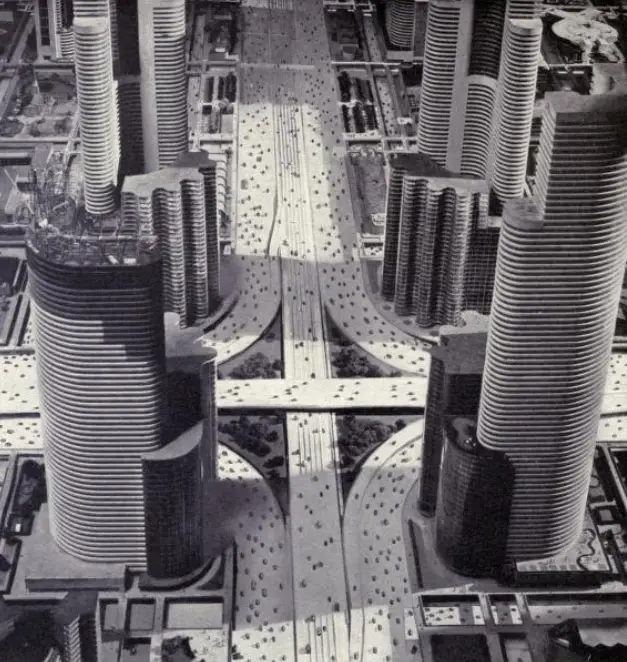
Details of the Futurama diorama
(Wiki Image By Richard Garrison – https://archive.org/stream/magicmotorways00geddrich#page/240/mode/2up, Public Domain, https://commons.wikimedia.org/w/index.php?curid=67871017)
“Futurama” was the most popular and influential exhibit at the 1939-40 New York World’s Fair. Sponsored by General Motors and designed by Norman Bel Geddes, it was a massive, 1-acre animated diorama of the United States as it might look in the “future” of 1960.
The “wonder” of the exhibit was its revolutionary vision of an “auto-centric” America, which introduced the public to a new, streamlined world.
The “World of Tomorrow” showcased
The exhibit was a detailed, utopian vision of a nation connected by a vast network of 14-lane superhighways. The diorama featured:
- 50,000 miniature, streamlined cars (10,000 of which were in motion).
- 500,000 individually designed buildings.
- 1,000,000 trees of 13 different species.
It depicted a future where cities were neatly segregated from the countryside by these massive highways, and sprawling suburbs were the new ideal. It was the first time most Americans had ever seen the concept of an interstate highway system.
The Visitor Experience
The exhibit was an 18-minute ride, not just a static display.
- The Ride: Visitors (30,000 per day) sat in moving “sound-chairs” on a conveyor belt.
- The View: The chairs provided a simulated, low-altitude “airplane flight” over the entire model.
- The Narration: A synchronized audio track explained the wonders of this new world, with its automated vehicle spacing and perfectly planned cities.
At the end of the ride, visitors emerged into a full-scale, “futuristic” 1960s street intersection and were given a pin proclaiming, “I Have Seen the Future.”
The exhibit was so powerful and popular that its vision of an America connected by superhighways became a central goal of post-war development, directly influencing the creation of the U.S. Interstate Highway System in the 1950s.
This 1940 General Motors film shows the ride thousands of people took through the “Highways and Horizons” pavilion. To New Horizons
New York 1939-40: The World of Tomorrow. Elektro the Moto-Man
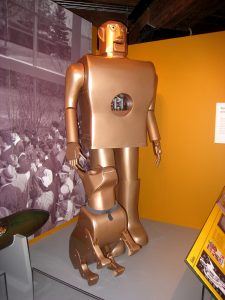
Replicas of Elektro the moto-man and his little dog Sparko
(Wiki Image By Daderot – Self-photographed, Public Domain, https://commons.wikimedia.org/w/index.php?curid=12275928)
“Elektro the Moto-Man” was the undisputed celebrity and star attraction of the Westinghouse pavilion. He was a 7-foot-tall, 265-pound humanoid robot who, for millions of visitors, was a living, mechanical embodiment of the “World of Tomorrow.”
Why He Was a “Wonder”
- A “Living” Robot: In an era when robots were pure science fiction, Elektro was a mechanical marvel. He could walk (by responding to voice commands), move his arms and head, and “speak” a vocabulary of about 700 words using a 78-rpm record player.
- Human-like Personality: He wasn’t just a machine; he was a “Moto-Man.” He had a witty, bragging personality. He would introduce himself, boast (“I have a very fine brain!”), and perform tricks for the audience.
- The “Tricks”: His most famous (and bizarre) “wonder” was his ability to smoke cigarettes. He would raise a cigarette to his “mouth,” and smoke would billow from his “nostrils.” He could also blow up balloons.
- The Robot Dog: As if Elektro wasn’t enough, he also had a sidekick: Sparko, a robot dog who could bark, sit, and wag his tail.
Elektro was the perfect symbol of the fair: a futuristic, entertaining, and slightly strange vision of a future where machines would become part of daily life.
New York 1939-40: The World of Tomorrow. The “Talking” Voder

Voder, a keyboard-operated speech synthesizer, was demonstrated at the fair.
(Wiki Image By Internet Archive Book Images – https://www.flickr.com/photos/internetarchivebookimages/14570193247/Source book page: https://archive.org/stream/belltelephonemag19amerrich/belltelephonemag19amerrich#page/n80/mode/1upReference[Fig.6] Audition 1 Hearing Themselves as Others Heard Them from: Williams, Thomas W. (January 1940) I. At the New York World’s Fair. “Our Exhibits at Two Fairs”. Bell Telephone Quarterly XIX (1): 67.”Audition 1 Hearing Themselves as Others Heard Them — The dummies on the stage appear to be repeating the conversation just completed by a group now seated at the foot of the garden ”, No restrictions, https://commons.wikimedia.org/w/index.php?curid=43353808)
The Voder (an acronym for Voice Operation Demonstrator) was one of the scientific marvels of the 1939 World’s Fair. It was a “wonder” because, unlike the phonograph, which replayed sound, the Voder was the first machine to synthesize human speech electronically from scratch.
It was the main attraction at the Bell Telephone Laboratories pavilion.
How It Worked
The Voder was a complex electronic device that looked like a large, curved organ. To make it “talk,” a highly trained operator (called a “Voderette”) would sit at the console and manipulate its controls.
- No Recordings: The machine did not use any pre-recorded words.
- Controls: The operator used 10-finger keys to create the basic “hiss” and “buzz” sounds of speech, a wrist bar to select vowel sounds, and a foot pedal to control pitch (inflection).
- Creating Speech: By blending electronic tones, hisses, and hums in real time, a skilled operator could form recognizable words and sentences.
The “Wonder” and Visitor Experience
The Voder was a sensation. Visitors would pack the Bell pavilion’s auditorium to watch the “Voderettes” conduct live demonstrations. The operators would make the Voder say phrases like “Good afternoon, ladies and gentlemen,” and even answer questions from the audience.
The resulting voice was robotic, eerie, and often challenging to understand, but it was unmistakably synthesized speech. It was a powerful, and for many, a “magical” glimpse into a future where machines could think and talk. The Voder was the direct ancestor of all modern speech synthesizers and digital assistants, such as Siri and Google Assistant.
New York 1939-40: The World of Tomorrow. The First Television Broadcast
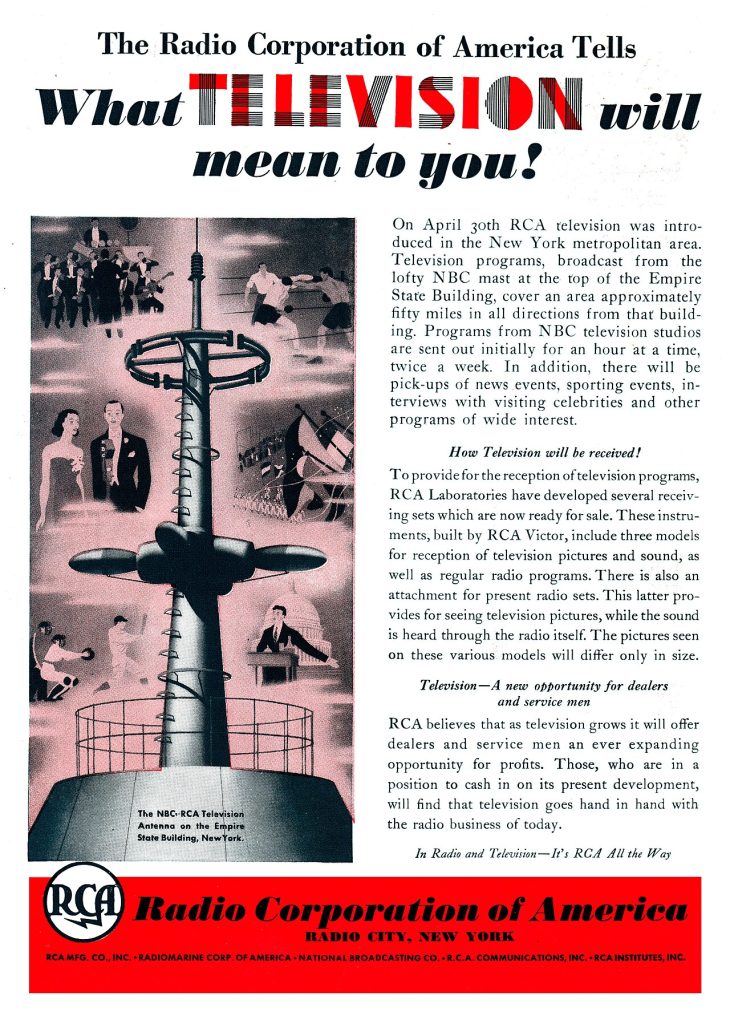
Ad for the beginning of experimental television broadcasting in New York City by RCA in 1939
(Wiki Image By Radio Corporation of America, Radio City, New York City, NY – (Original text: “Radio & Television” (magazine) Vol. X, No. 2, June 1939. (inside front cover) New York: Popular Book Corporation”The Cooper Collections ” (uploader’s private collection)Digitized by Centpacrr), Public Domain, https://commons.wikimedia.org/w/index.php?curid=38539343)
This was the “wonder” that truly launched the “World of Tomorrow.” The 1939 World’s Fair was the site of the first significant public television broadcast in American history, marking the birth of television as a commercial industry.
This event was orchestrated by the Radio Corporation of America (RCA) and its president, David Sarnoff, at the grand opening of the RCA Pavilion.
- The Historic Broadcast (April 30, 1939)
The “wonder” was the official, live broadcast of the fair’s opening ceremonies. A massive, mobile television camera van captured the event and transmitted it to a small number of receivers.
The broadcast featured President Franklin D. Roosevelt’s speech, making him the first sitting U.S. president to appear on television. David Sarnoff also gave a famous speech, dedicating the RCA pavilion and proclaiming the “birth of a new art… which is bound to affect all society.”
- The Visitor Experience (The “Magic”)
While only a few hundred people in the New York area saw the initial broadcast on TV sets, the real “wonder” for millions of visitors was at the RCA Pavilion.
- Seeing Television: Visitors could walk into the pavilion (itself shaped like a giant radio tube) and see this new invention for themselves. They watched the live broadcasts on small, 5-inch black-and-white screens.
- The “Transparent TV”: To prove it wasn’t a hoax or a movie projector trick, RCA displayed one of its television sets in a transparent Lucite (plastic) case so that visitors could see the “magic” inner workings.
- Seeing Themselves on TV: The most popular part of the exhibit was an RCA television camera set up inside. Visitors could line up, stand in front of it, then walk over to a monitor to see their own image. For the first time, people were not just watching a broadcast; they were in it.
New York 1939-40: The World of Tomorrow. Railroads on Parade
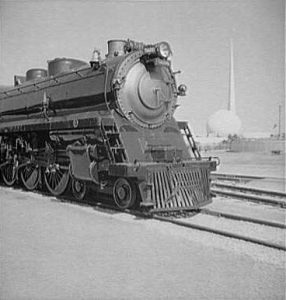
World’s Fair railroad exhibit. Baltimore and Ohio Class N-1 steam locomotive, #5600 George H. Emerson and Trylon and Perisphere.
https://commons.wikimedia.org/wiki/Category:Locomotives_in_the_1939_New_York_World%27s_Fair
“Railroads on Parade” was one of the most popular and spectacular “wonders” of the 1939-40 New York World’s Fair. It was not a static display but a massive, live-action outdoor musical pageant that told the history of American railroads.
Sponsored by the Eastern Railroads, this “circus opera” was a colossal production.
Why It Was a “Wonder”
- Real, Working Locomotives: This was the main spectacle. The show used 20 actual, full-size locomotives (and 50 horses) that moved across a gigantic, double-tracked stage under their own steam. The stage, the largest ever built in New York, faced a 4,000-seat amphitheater.
- Massive Scale: The production featured a cast of 250 performers, a 100-person crew, and an orchestra. It was a “fantasia on rail transport” that re-enacted historical moments, from the 1820s stagecoach to the arrival of modern streamliners.
- Innovative Sound Engineering: Because of the immense noise from the real engines, the orchestra and singers actually performed in a sound room under the stage. Their voices and music were amplified through a modern speaker system, while the 250 actors on stage lip-synced their parts—a massive and complex feat of audio-visual coordination for 1939.
The show was so popular that it drew over 2 million people during the fair’s 2-year run.
This home movie from 1939 shows the full scale of the “Railroads on Parade” show. Railroads On Parade at the New York World’s Fair
New York 1939-40: The World of Tomorrow. The Parachute Jump

The ride was operating at the 1939 World’s Fair.
(Wiki Image By Gottscho-Schleisner, Inc., photographer – This image is available from the United States Library of Congress’s Prints and Photographs divisionunder the digital ID gsc.5a30777.This tag does not indicate the copyright status of the attached work. A normal copyright tag is still required. See Commons:Licensing., Public Domain, https://commons.wikimedia.org/w/index.php?curid=1850026)
The Parachute Jump was one of the most popular and thrilling “wonders” of the 1939-40 New York World’s Fair, located in the “Amusement Zone.”
It was a 250-foot-tall (80 m) steel tower, inspired by training towers used for paratroopers.
Why It Was a “Wonder”
- The Thrill: It was a pure, high-adrenaline amusement ride. Visitors were strapped into two-person seats under a large parachute, hoisted to the very top of the tower, and then dropped.
- The “Controlled” Fall: The “wonder” was the terrifying-yet-safe sensation of a free fall, which was then slowed by the large parachute opening and guided by steel cables.
- The View: From the top, riders had a breathtaking, unparalleled view of the entire World’s Fair, the New York skyline, and the surrounding area before they were dropped.
The Legacy: “The Eiffel Tower of Brooklyn”
The ride was so popular that after the fair closed, it was moved in 1941 to Coney Island, Brooklyn. It operated there as a beloved, if terrifying, amusement ride until the 1960s.
Today, the structure is a landmark. Although it no longer operates as a ride, the “Parachute Jump” still stands as the iconic, skeletal symbol of Coney Island, known as “The Eiffel Tower of Brooklyn.”
New York 1939-40: The World of Tomorrow. “The Dawn of a New Day”
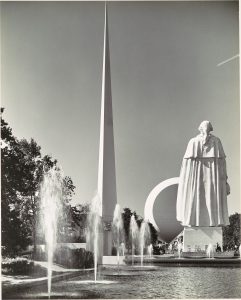
A fountain at the World’s Fair, with the Trylon and Perisphere in the background
(Wiki Image By Creator: Samuel H. Gottscho – This file was donated to Wikimedia Commons as part of a project by the Metropolitan Museum of Art. See the Image and Data Resources Open Access Policy, CC0, https://commons.wikimedia.org/w/index.php?curid=60426654)
“The Dawn of a New Day” was the official theme song of the 1939 World’s Fair, but it was also the name of the spectacular show inside the General Electric (GE) Pavilion.
This exhibit, also known as the “House of Magic,” was a “wonder” because it was a high-tech, theatrical “magic show” designed to demonstrate the awesome power of electricity.
Why It Was a “Wonder”
- Artificial Lightning: The show’s stunning climax was the creation of 10-million-volt artificial lightning. A massive Marx generator would discharge a deafening, 30-foot bolt of electricity across the stage.
- The “Talking” Kitchen: The show featured a futuristic, all-electric kitchen. An unseen operator (the “voice”) would carry on a conversation with the demonstrator, making the appliances “talk” and operate on their own.
- Debut of Fluorescent Lighting: The pavilion was the first major public introduction of the fluorescent lamp. Visitors were amazed by this new, efficient light source that was cool to the touch.
- “Magic” Demonstrations: The show used magnetism to make objects float, sound to put out fires, and high-frequency currents to “cook” food over a wooden table.
It was a masterful piece of corporate theater, using drama and spectacle to show visitors that electricity was not just a utility, but a “genie in a bottle” that would power the “World of Tomorrow.”
New York 1939-40: The World of Tomorrow. The Aquacade
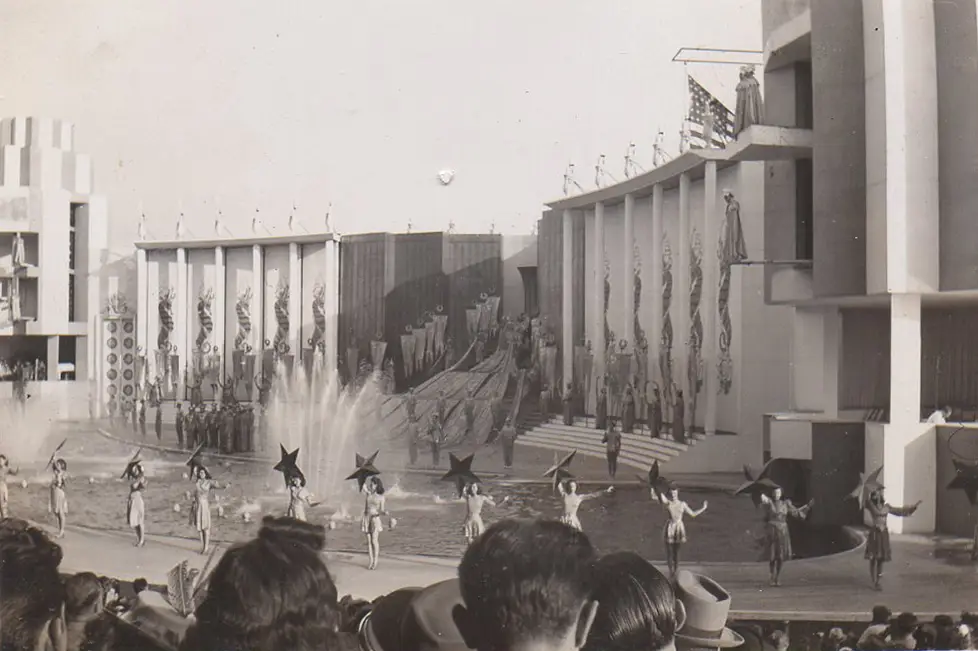
The Billy Rose’s Aquacade amphitheater, one of the few structures to remain after the fair
(Wiki Image By Waeltkm – Own work, CC BY-SA 4.0, https://commons.wikimedia.org/w/index.php?curid=63971211)
The Aquacade was the smash-hit, blockbuster entertainment “wonder” of the 1939-40 New York World’s Fair.
It was not a traditional exhibit but a massive, live-action water-and-music spectacle produced by the famous showman Billy Rose.
Why It Was a “Wonder”
- Massive Scale: The show was performed in a custom-built, 11,000-seat amphitheater, centered around a gigantic 275-foot-long swimming pool, with a stage that could be raised or lowered.
- Star Power: The show featured the two biggest swimming celebrities of the era: Eleanor Holm (an Olympic swimmer who was famously kicked off the 1936 team) and Johnny Weissmuller (an Olympic gold medalist who was famous for playing Tarzan in the movies).
- The Spectacle: It was a “water ballet” on an epic scale. It featured a massive cast of over 500 performers (known as the “Aquabelles” and “Aquadudes”), who performed synchronized swimming, comedy routines, and high-diving acts, all set to a live orchestra and dazzling lighting effects.
The Aquacade was the fair’s most popular and profitable attraction. It was a pure, glittering spectacle that defined the “entertainment” side of the “World of Tomorrow.”
🚀 New York 1939-40: The World of Tomorrow. YouTube Video Links Views
Here are several YouTube videos that offer fantastic views and historical context for the 1939-40 New York World’s Fair, “The World of Tomorrow.”
-
-
- Channel: Aeon Video
- Views: Over 68,000
- Description: This excellent documentary uses rare color footage and mines the memories of people who attended the fair as children. It perfectly captures the event’s sense of wonder, optimism, and futuristic spectacle.
-
-
-
- Channel: US Auto Industry
- Views: Over 80,000
- Description: This is the original promotional film by General Motors, showing the legendary “Futurama” exhibit. It’s the best way to see the most popular ride at the fair, which presented a “wonder world of 1960” with superhighways and futuristic cities.
-
-
- Channel: (Channel name not in snippet)
- Views: (View count not specified)
- Description: This video provides a vibrant, silent tour of the fair in rare Kodachrome color. It showcases the pavilions (Soviet, British, Japanese), the Aquacade, the Parachute Jump, and the dazzling nighttime fireworks.
This film from Aeon Video is a great starting point, combining rare color footage with the personal memories of those who saw “The World of Tomorrow” firsthand.
🚀 New York 1939-40: The World of Tomorrow. Books
Here are the essential books about the 1939-40 New York World’s Fair, “The World of Tomorrow,” from comprehensive histories to “time-capsule” photo collections.
🏛️ Comprehensive History
“The World of Tomorrow: The 1939 New York World’s Fair” by Larry Zim, Mel Lerner, and Herbert Rolfes
This is the definitive, classic history of the fair. It’s a large-format book packed with over 470 illustrations (many in color) and a detailed, engaging text. It covers the fair’s conception, its incredible pavilions (like the GM Futurama and the Westinghouse robot), its grand vision, and its poignant end on the brink of World War II. It’s the best all-in-one book for a deep, historical understanding.
📸 Visual Guides & Photo Books
“1939 New York World’s Fair: The World of Tomorrow in Photographs” by Mark Bussler
This book is a fantastic, accessible guide to the fair. It features hundreds of photographs (many previously unpublished) that give you an on-the-ground perspective. It’s an informative tour that guides you through the Trylon and Perisphere, the Futurama, Billy Rose’s Aquacade, and the other famous exhibits.
“The 1939-1940 New York World’s Fair” by Bill Cotter (Images of America series)
Part of the popular “Images of America” series, this book uses over 200 rare, vintage photographs to tell the story of the fair. It’s less a dense history and more a “time-capsule” tour, with a focus on candid, never-before-published snapshots that capture visitors’ real-life experiences.
📖 Literary & Cultural Impact
“World’s Fair” by E.L. Doctorow
This is a Pulitzer Prize-winning novel, not a history book, but it’s essential for understanding the fair’s cultural impact. It’s a fictionalized memoir of a young boy growing up in the Bronx during the Depression, culminating in his life-changing visit to the “World of Tomorrow.” It perfectly captures the sense of wonder and hope that the fair represented to a generation.
🕰️ Primary Source (For Collectors)
“Official Guide Book: New York World’s Fair 1939”
You can often find original or replica copies of the official guidebook sold at the fair. This is the ultimate primary source, allowing you to see the fair exactly as its organizers presented it to the public, with maps, exhibit descriptions, and official sponsors.
🌍 Montreal 1967: Expo 67.
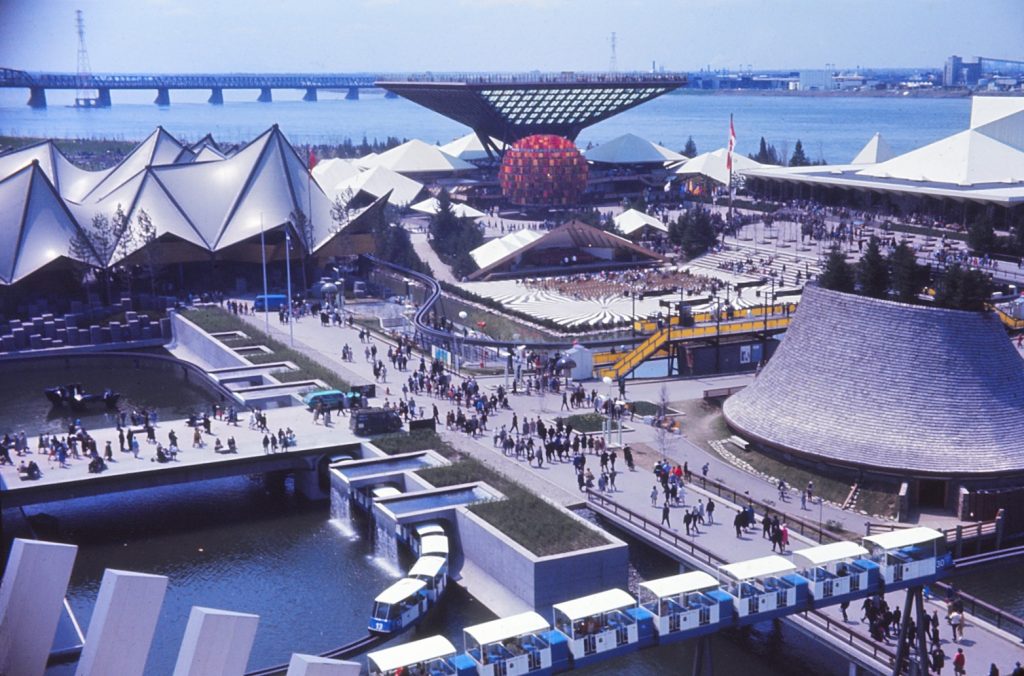
Canada Pavilion, shown with the Ontario and Western Provinces pavilions
(Wiki Image By Laurent Bélanger – Own work, CC BY-SA 3.0, https://commons.wikimedia.org/w/index.php?curid=30298079)
🌍 Montreal 1967: Expo 67. Quotes
Great question. Here are some notable quotes from or about Expo 67 (Montreal, 1967):
🗣️ Key Quotes from Expo 67
- Lester B. Pearson, Canadian Prime Minister, Opening Remarks:
“Back of this big Canadian birthday ‘blast’ are achievements in planning, organization, and construction that are little short of miraculous … Expo … is also a monument to Man … it tells the … story of a world that belongs not to any one nation but to every nation.” Expo 67
And later:
“The genius of Man knows no national boundaries but is universal.” TIME+1 - Queen Elizabeth II, at Expo 67:
“Canadians have … deliberately chosen cultural and social diversity. Concerned … with unity … they are nonetheless profoundly faithful to their origins.” Expo 67
And:
“Canada … sees an essential mark of its own identity … in the fruitful dialogue between its national cultures … a condition of its survival.” Expo 67 - Lyndon B. Johnson, U.S. President, visiting Expo 67:
“Your magnificent EXPO ’67 … heightens my interest … knowledge that this is your centennial anniversary …” The American Presidency Project - Charles de Gaulle, French President (very famous, more political than about Expo itself, but deeply tied):
“Vive Montréal! Vive le Québec! … Vive le Québec libre!” Wikipedia - Mayor of Montreal (at 40th anniversary), Gérald Tremblay, remembering the spirit:
“When everything was possible … Montréal was thinking about herself as the best and was aiming to stay the best.” Expo 67
If you like, I can dig into archival speeches and find 20+ original quotes (from pavilions, architects, participants) about Expo 67. Do you want me to do that?
🌍 Montreal 1967: Expo 67. History

Site map of Expo 67, highlighting 20 of the 90 pavilions
(Wiki Image By Thomas Römer/OpenStreetMap data, CC BY-SA 2.0, https://commons.wikimedia.org/w/index.php?curid=11078969)
Here is the history of the 1967 World’s Fair in Montreal, “Expo 67.”
🌍 Man and His World
Expo 67, whose official theme was “Terre des Hommes” (“Man and His World”), was the defining and most successful World’s Fair of the 20th century. It was a massive cultural celebration that, for six months, captured a spirit of global optimism and cooperation.
The fair was held from April 27 to October 29, 1967, and was the main celebration of Canada’s 100th birthday (its Centennial).
The Audacious Vision
The fair was the passion project of Montreal’s charismatic mayor, Jean Drapeau. When Montreal was awarded the fair, it had a significant problem: no land.
Drapeau’s solution was a marvel of engineering. Over four years, construction crews used 25 million tons of rock and fill—excavated from the construction of the new Montreal Metro—to create an entirely new island (Île Notre-Dame) and expand the existing Île Sainte-Hélène in the middle of the St. Lawrence River. The fair was, quite literally, built from the ground up.
The Theme: A Humanist Utopia
Unlike the corporate, futuristic visions of the 1939 New York fair, Expo 67’s theme was humanist. Based on the book Terre des Hommes by Antoine de Saint-Exupéry, it was designed to be a “poem to man” and his place in the universe.
This theme was a massive success, attracting 90 nations that participated through pavilions exploring art, society, and culture rather than just industrial products.
The Architectural Icons
The fair’s legacy is its groundbreaking architecture, which still defines Montreal today.
- Habitat 67: Designed by Moshe Safdie, this was a revolutionary housing complex made of 354 pre-fabricated, stacked concrete modules. It was a “living” pavilion, a radical vision for the future of urban, high-density living.
- The U.S. Pavilion: A 20-story, 250-foot-diameter geodesic dome designed by Buckminster Fuller. The “Biosphere” was a “wonder” of futuristic design, housing an exhibit on the U.S. Space Race.
- The Soviet Pavilion: The Cold War rival to the U.S. dome, this massive, “ski-jump” roofed pavilion was the fair’s most popular, drawing huge crowds with its own exhibit of Sputnik and Vostok space capsules.
- The Labyrinth: This was the National Film Board of Canada’s pavilion, an innovative, multi-screen, immersive cinema experience that was the direct precursor to the IMAX format.
The “Summer of Love” and Its Legacy
Expo 67 was an unprecedented triumph. It perfectly captured the optimistic spirit of 1967’s “Summer of Love.”
- A “Coming of Age”: The fair was a “coming of age” moment for Canada, transforming its image from a quiet, “lumberjack” nation to a sophisticated, modern, and multicultural country.
- Record Attendance: It was a huge party, attracting over 50 million visitors in six months (a per-capita record that has never been broken) at a time when Canada’s entire population was only 20 million.
- Enduring Legacy: Today, the man-made islands host a park, the Circuit Gilles Villeneuve (a Formula 1 racetrack), and the Montreal Casino. The U.S. Pavilion’s geodesic dome still stands as the Biosphère, an environmental museum.
This documentary from the NFB of Canada captures the spirit and construction of the fair. Expo 67: The Big Fair
🌍 Montreal 1967: Expo 67. Eight Wondrous Exhibition
Expo 67, held in Montreal, celebrated Canada’s 100th birthday. Its theme was “Man and His World” (Terre des Hommes), and it’s widely regarded as the most successful and optimistic World’s Fair of the 20th century.
Its defining icons were architectural marvels that still exist today: Habitat 67, a revolutionary modular housing complex, and the American Pavilion, a massive geodesic dome designed by Buckminster Fuller.
Here are eight of the most wondrous exhibits and attractions from Expo 67.
8 Wondrous Exhibits of Expo 67
| Exhibit | Origin | Significance & “Wonder” |
| 1. Habitat 67 | Canada | A “wonder” of architecture. Designed by Moshe Safdie, this was a living proof pavilion: a futuristic, brutalist housing complex made of 354 prefabricated concrete modules stacked like blocks. It was a radical vision for the future of urban living. |
| 2. U.S. Pavilion (Geodesic Dome) | United States | A 20-story, 250-foot-diameter “biosphere” designed by Buckminster Fuller. It was a “cathedral of the future,” enclosing a multi-level exhibit on American space technology (like Apollo capsules) and culture, and it became an icon of 1960s futurism. |
| 3. Soviet Pavilion | USSR | The great Cold War rival to the U.S. dome, this was a massive, “ski-jump” roofed pavilion. The “wonder” was its “Cosmos” exhibit, a dazzling display of space technology, including Sputnik models and Vostok spacesuits, showcasing the USSR’s lead in the space race. |
| 4. Labyrinth Pavilion | Canada | A groundbreaking immersive cinema experience created by the National Film Board of Canada. It was a multi-level, maze-like building where visitors experienced a multi-screen, sensory story. It was the direct technological precursor to the IMAX format. |
| 5. The Minirail | Expo | The fair’s primary transportation system was an attraction in itself. This sleek, colorful, elevated monorail silently glided through many of the main pavilions (including the U.S. dome), offering futuristic views of the entire site. |
| 6. Czechoslovakian Pavilion | Czechoslovakia | The surprise artistic and technological hit of the fair. It wowed audiences with innovative “Polyvision” multimedia shows and the “Kino-Automat,” the world’s first interactive movie, in which the audience could vote on which of two scenes would come next. |
| 7. Indians of Canada Pavilion | First Nations of Canada | A landmark cultural “wonder.” This was the first World’s Fair pavilion organized by Indigenous peoples. It was a powerful and, for its time, radical statement. Instead of celebrating the fair’s theme, its central message was “The Indian’s world is a world apart,” challenging the optimistic narrative. |
| 8. La Ronde | Expo | The fair’s permanent amusement park, which still operates today. It was a wonderland of modern rides, roller coasters (like “Le Monstre”), and entertainment. It represented the “playful” side of the “Man and His World” theme. |
Montreal 1967: Expo 67. Habitat 67
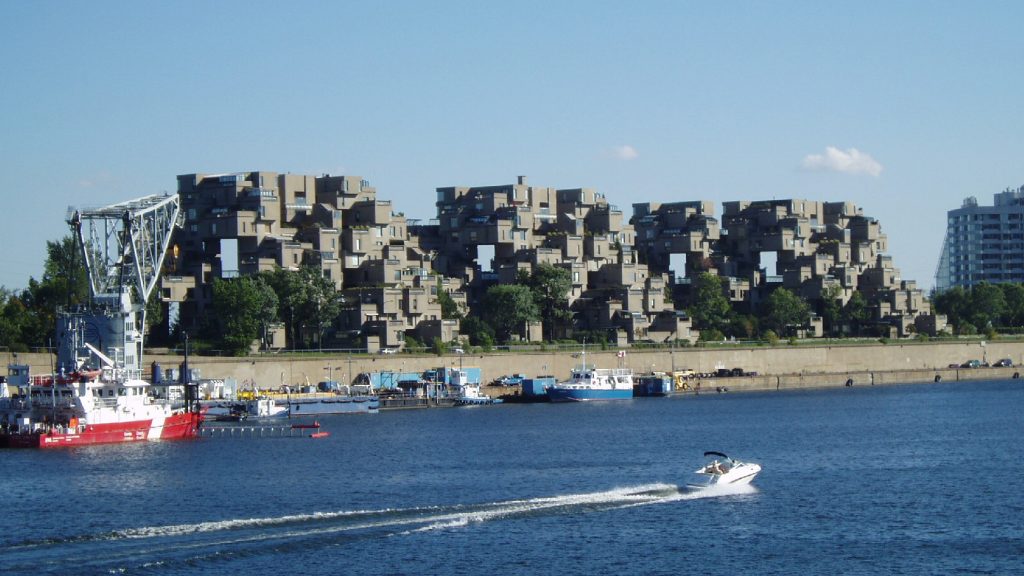
Habitat 67, a housing complex built for Expo 67
(Wiki Image By Eberhard von Nellenburg – de:Bild:Habitat.jpg, CC BY-SA 3.0, https://commons.wikimedia.org/w/index.php?curid=511586)
Habitat 67 was one of the central “wonders” and most enduring icons of Expo 67.
It was not a traditional pavilion; it was a visionary, experimental housing complex designed by the Israeli-Canadian architect Moshe Safdie (then in his 20s), based on his university thesis.
Why It Was a “Wonder”
- A Radical Vision for Urban Living: Habitat 67 was a real, functioning apartment building that served as a “living” exhibit. Its goal was to rethink high-density urban life. Safdie wanted to combine the density of an apartment building with the privacy, outdoor space, and individuality of a suburban home.
- Revolutionary Modular Design: The building is a stunning, Brutalist structure that looks like a jumble of stacked blocks. It was constructed from 354 identical, pre-fabricated concrete modules (or “boxes”) that were built on the ground and then lifted into place by a crane.
- “A Garden for Everyone”: The “wonder” of its design is that each apartment, through clever stacking of modules, has its own private, open-air rooftop garden (on the roof of the unit below).
Its Significance and Legacy
Habitat 67 was a sensation at the fair. It was a tangible, livable, and radical blueprint for the “future of housing” and the “Man and His World” theme.
Unlike most fair pavilions, Habitat 67 was built to be permanent. After the fair, it was converted into a residential apartment building, and it remains one of the most prestigious and sought-after addresses in Montreal. It is a world-famous landmark of 20th-century architecture.
Montreal 1967: Expo 67. U.S. Pavilion (Geodesic Dome)
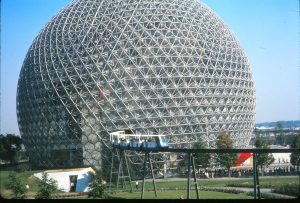
USA Pavilion (with minirail)
(Wiki Image By CA2MI – Own work, CC BY-SA 4.0, https://commons.wikimedia.org/w/index.php?curid=96130960)
The U.S. Pavilion at Expo 67 was one of the most iconic and celebrated structures of the entire fair. It was a massive geodesic dome, a “wonder” of futuristic design by the famous architect and inventor Buckminster Fuller.
Why It Was a “Wonder”
- A “Biosphere” of the Future: The dome was a colossal, 20-story-high (250-foot-diameter) sphere. It was not a solid building but a delicate steel lattice frame covered with thousands of transparent, tinted acrylic panels. It looked like a giant, shimmering bubble.
- A Symbol of American Ingenuity: At the height of the Cold War, this building was America’s “soft power” answer to the massive, ski-jump-roofed Soviet pavilion nearby. It was light, airy, and futuristic, designed to awe visitors with its high-tech beauty.
- The Immersive “Moon” Exhibit: Inside, the dome was a multi-level exhibit. The main attraction was a stunning “space race” display, featuring actual Apollo space capsules and lunar landers, which made visitors feel as if they were walking on the moon.
- Pop Art and Culture: The rest of the exhibit was a “snapshot” of 1960s America, featuring massive pop art paintings (such as a giant photo of a cat), Hollywood memorabilia, and other cultural artifacts.
Its Legacy: The Montreal Biosphère
The U.S. Pavilion was so successful that, like Habitat 67, it was made permanent.
However, in 1976, a fire during welding repairs destroyed the entire acrylic skin of the dome, leaving only the intricate, bare steel skeleton. This “skeleton” remained a famous Montreal landmark for years.
In the 1990s, the structure was enclosed and repurposed. Today, it is the Montreal Biosphère, an environmental museum dedicated to water and climate change, and it remains one of the city’s most recognizable symbols.
Montreal 1967: Expo 67. Soviet Pavilion

Most visited: USSR Pavilion; the Expo 67 Soviet pavilion was disassembled after the fair closed and moved to Moscow, where it became the Moscow Pavilion at the All-Russia Exhibition Centre.
(Wiki Image By Laurent Bélanger – Own work, CC BY-SA 3.0, https://commons.wikimedia.org/w/index.php?curid=30770020)
The Soviet Pavilion was one of the largest, most expensive, and most popular exhibits at Expo 67. It was a massive, imposing building with a dramatic, curved “ski-jump” roof, designed to directly rival the airy, lightweight geodesic dome of the United States.
Why It Was a “Wonder”
- A “Wonder” of the Space Race: The main attraction and “wonder” inside was its spectacular “Cosmos” exhibit. At a time when the USSR was winning the space race, this was a dazzling display of Soviet technological supremacy. Visitors were awed by:
- Full-scale models of the Sputnik satellite and the Vostok rocket.
- Actual space capsules, spacesuits, and lunar rovers.
- A 360-degree film projection that simulated a “flight to the moon.”
- Imposing Architecture: The building itself was a statement. Its enormous, cantilevered roof (made of steel and glass) was an engineering marvel, creating a vast, open interior space to house its industrial and scientific exhibits.
- Cultural & Industrial Might: Beyond the space exhibit, the pavilion was a sprawling showcase of the USSR’s power, featuring everything from giant models of hydroelectric dams and new automobiles to folk art, fashion, and a restaurant.
The Soviet Pavilion was a massive propaganda victory. It was the most-visited pavilion at the fair, drawing over 13 million people and leaving them with a powerful impression of the USSR’s scientific and cultural achievements.
Montreal 1967: Expo 67. Labyrinth Pavilion
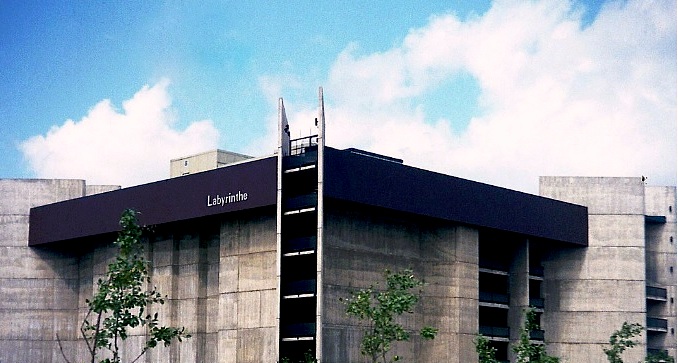
Labyrinth Pavilion at Universal Exposition of 1967, Montreal, Quebec, Canada
The Labyrinth Pavilion was one of the most innovative and philosophically ambitious “wonders” of Expo 67. It was not a traditional exhibit but a revolutionary, multi-sensory cinema experience created by the National Film Board of Canada (NFB).
Its “wonder” was that it was a “walk-through” film that guided visitors through a five-story building designed as a modern-day labyrinth. The experience was a metaphor for the Greek myth of Theseus and the Minotaur, with the audience (Man) navigating a maze to confront a monster (representing man’s own inner self).
The Labyrinth Pavilion is most famous today as the direct precursor to the IMAX format.
The Visitor Experience
The 45-minute journey was divided into three chambers:
- Chamber 1: Visitors stood on four balconies at different levels. They were confronted with two massive screens: one rising vertically from the floor and another lying flat on the floor far below. The film, using connected images (e.g., a baby on the floor screen and a father looking down at the vertical screen), created a powerful, disorienting sense of space and movement.
- Chamber 2: A transitional “maze” of dark, mirrored corridors filled with blinking lights and electronic sounds, designed to disorient the visitor.
- Chamber 3: A more conventional theater where visitors sat and watched the climax of the film, “In the Labyrinth.” This film was projected onto five screens arranged in the shape of a cross, a groundbreaking multi-screen technique that surrounded the audience with images.
Significance and Legacy
- A Technological Marvel: The pavilion’s use of multi-screen 70mm and 35mm film, combined with a 288-speaker stereophonic sound system, was unlike anything the public had ever experienced.
- The Birth of IMAX: The creators of Labyrinth, including Roman Kroitor and Colin Low, were so successful in creating an immersive, large-format experience that they went on to co-found the IMAX Corporation.
- A Critical Hit: It was a massive popular success, with lines often lasting two to four hours. The New York Times wrote that the Labyrinth was “as special to Expo 67 as the Eiffel Tower was to the Paris Exposition of 1889.”
Montreal 1967: Expo 67. The Minirail
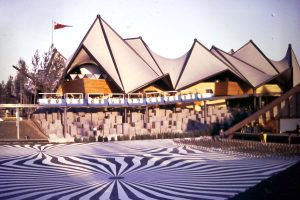
The minirail passes the Ontario pavilion.
(Wiki Image By Laurent Bélanger – Own work, CC BY-SA 3.0, https://commons.wikimedia.org/w/index.php?curid=30298079)
The Minirail was the primary transportation system at Expo 67 and one of its most beloved attractions. It was a “wonder” because it was a futuristic, elevated, automated light-rail system that silently glided through and around the fairgrounds, offering spectacular views.
It was, in essence, a ride that was also the main way to get around.
Why It Was a “Wonder”
- A Futuristic Ride: For most visitors in 1967, a sleek, automated, elevated “monorail” (though it ran on two beams rather than one) was pure science fiction. It was clean, quiet, and felt like an actual vehicle of the “World of Tomorrow.”
- The Immersive Journey: The Minirail’s route was a marvel. It didn’t just go to the pavilions; it went through them. The train would silently glide through the U.S. Pavilion (the Geodesic Dome) and the massive Soviet Pavilion, offering riders a stunning drive-through tour of the main exhibits.
- Spectacular Views: As an elevated system, it offered a continuous, panoramic “bird’s-eye view” of the entire fair, its futuristic architecture, and the Montreal skyline.
- A Symbol of the Fair: The colorful, streamlined trains (painted in red, white, or blue) became a moving, kinetic symbol of Expo 67’s optimistic, clean, and modern spirit. It was so popular that the lines to ride it were often as long as those for the main pavilions.
Montreal 1967: Expo 67. Czechoslovakian Pavilion

Expo 67, Czechoslovakia pavilion
(Wiki Image By Laurent Bélangercrop: Jan Polák – This image has been extracted from another file, CC BY-SA 4.0, https://commons.wikimedia.org/w/index.php?curid=55728763)
The Czechoslovakian Pavilion was the surprise critical and popular “wonder” of Expo 67. While the U.S. and Soviet pavilions were giant, expensive showcases of the space race, the smaller Czechoslovakian pavilion was the fair’s artistic and technological jewel.
It was so successful that it was one of the most-visited pavilions at the fair. Its exhibits were a masterpiece of multimedia, art, and wit.
Here are the “wonders” it contained:
- The Kino-Automat (The “Interactive Movie”)
This was the star of the show and the world’s first interactive movie.
- How it worked: A film would play, and at a key dramatic moment, the action would freeze. The film’s protagonist (a bumbling man) would walk out onto the stage, wring his hands, and ask the audience what he should do next.
- The Vote: The audience would then vote by pressing a red or green button at their seat.
- The Result: The film would then continue, playing out the scene based on the audience’s choice. This blend of live-action theater and interactive, branching-path filmmaking was revolutionary and a massive hit.
- Polyvision and Diapolyecran
These were two other groundbreaking multimedia shows that stunned audiences:
- Polyvision: This was a multi-screen, multi-projector system that used rotating cubes and synchronized screens to tell a story through a rapid-fire collage of images.
- Diapolyecran: This was a massive wall made of 112 moving cubes. Each cube contained its own slide projector, and the entire wall would change, move, and project a dazzling, complex mosaic of images set to music.
- Bohemian Glass
The pavilion was also a showcase of Czechoslovakia’s centuries-old glassmaking tradition. It featured enormous, modern, and breathtakingly beautiful sculptures made of Bohemian glass, which were illuminated and treated as high art.
The pavilion was a triumph of human-scale creativity, art, and technology. It was especially poignant, as it represented the cultural “thaw” of the “Prague Spring,” a burst of freedom that would be crushed by the Soviet invasion just a year later.
Montreal 1967: Expo 67. Indians of Canada Pavilion
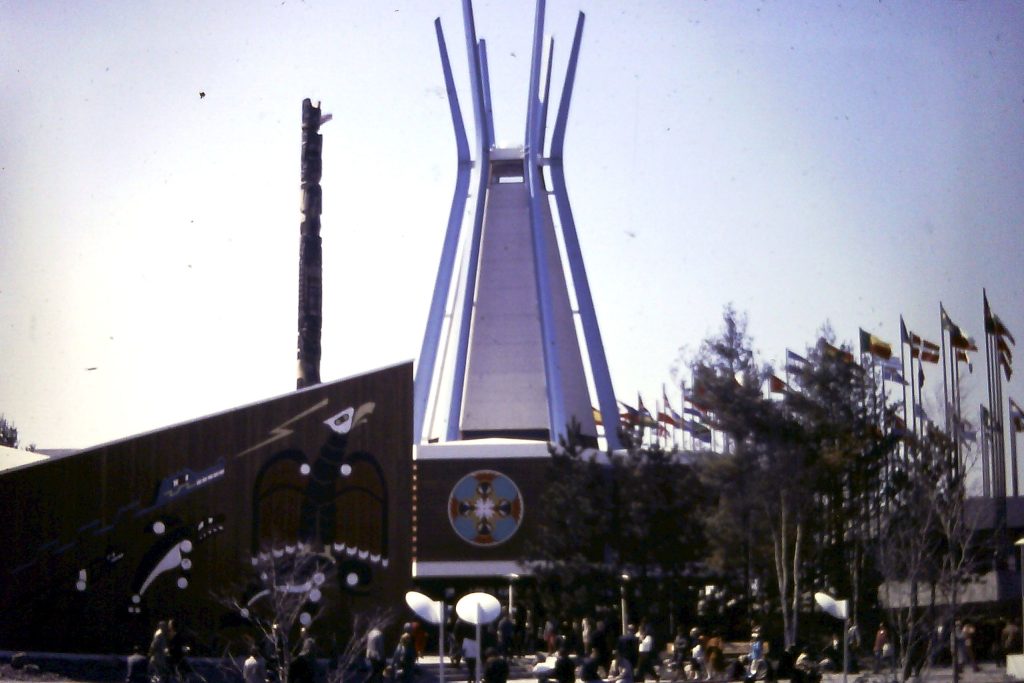
Indians of Canada pavilion.
(Wiki Image By The Webhamster from Ottawa, Canada – Expo 67 – Indians of Canada PavilionUploaded by Skeezix1000, CC BY-SA 2.0, https://commons.wikimedia.org/w/index.php?curid=12647073)
The Indians of Canada Pavilion was one of the most powerful, controversial, and historically significant “wonders” of Expo 67.
It was a landmark moment because it was the first time in World’s Fair history that Indigenous peoples (First Nations, Métis, and Inuit in Canada) were given their own pavilion to tell their own story, rather than being displayed as a “human zoo” or part of a colonial exhibit.
However, the “wonder” of this pavilion was that its organizers—a group of Indigenous leaders and artists—hijacked the project and refused to celebrate Canada’s 100th birthday. Instead, they created a powerful “protest pavilion.”
Why It Was a “Wonder”
- A Radical Act of Protest: The Canadian government had expected a pavilion showing “happy Indians” carving totem poles and celebrating 100 years of “progress.” Instead, the pavilion was a sharp, angry, and truthful critique of Canada’s treatment of its Indigenous peoples.
- The “Anti-Theme”: The fair’s theme was “Man and His World.” The pavilion’s guide openly stated that its message was “The Indian’s world is a world apart.” The central message, displayed for all to see, was: “We were here for 10,000 years… you have been here for 100… what have you done?”
- A Contemporary, Not Historical, Exhibit: It was not a museum of the past. While it featured beautiful art, it also used stark, modern displays, photographs, and text to talk about the realities of 1967:
- Poverty on reserves.
- High infant mortality rates.
- The loss of land and culture.
- The failures of the residential school system.
The pavilion’s challenging, unapologetic honesty was a shock to many visitors and government officials. It was a “wonder” because it was a brave, unprecedented act of political and cultural self-representation that used the global stage of the World’s Fair to demand that the world listen to the real story of Canada’s Indigenous peoples.
Montreal 1967: Expo 67. La Ronde
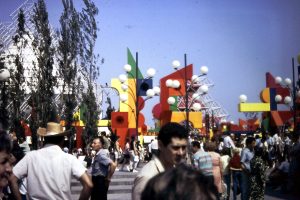
La Ronde during Expo 67. The amusement park was built as an entertainment complex for the World’s Fair.
(Wiki Image By The Webhamster from Ottawa, Canada – Expo 67 – Crowds And ColourUploaded by Skeezix1000, CC BY-SA 2.0, https://commons.wikimedia.org/w/index.php?curid=12647324)
La Ronde was the amusement park section of Expo 67. Unlike the temporary midways of previous fairs, La Ronde was built as a permanent entertainment complex on the northern tip of Île Sainte-Hélène.
Why It Was a “Wonder”
- A Permanent, Modern Park: It was a “wonder” because it was a fully-fledged, futuristic amusement park, not a collection of traveling carnival rides. It was designed to be a permanent legacy of the fair.
- Part of the Theme: It was an integral part of the “Man and His World” theme, specifically representing “Man at Play.”
- Key Attractions: It featured a variety of innovative and popular attractions, including:
- Le Monstre: A massive wooden roller coaster (though added later, it’s now the park’s icon).
- The Gyrotron: A large, futuristic ride that took visitors on a simulated journey into space and a volcano.
- The Skyride: A popular cable car system that gave spectacular views of the fairgrounds and the Montreal skyline.
Its Legacy
La Ronde was an enormous success and, unlike most fair attractions, it never closed. After Expo 67, it continued to operate as a city-run amusement park for decades.
Today, it is still in operation, owned and run by Six Flags. It remains a major Montreal attraction and a direct, living legacy of Expo 67.
🌍 Montreal 1967: Expo 67. YouTube Video Links Views
Here are several YouTube documentaries and videos that capture the history, architecture, and optimistic spirit of Expo 67 in Montreal.
-
-
- Channel: British Pathé
- Views: (Not specified, but British Pathé is a central historical archive)
- Description: This is a fantastic, original 1967 color newsreel. It provides a contemporary tour of the fair, showcasing the Minirail, the British pavilion, Habitat 67, and the overall “wonderland of tomorrow.”
-
-
-
- Channel: National Film Board of Canada (NFB)
- Views: (Not specified, but NFB is the official source)
- Description: This 18-minute 1967 documentary is a visit to the “Indians of Canada” pavilion. It’s a powerful primary source that shows the exhibits and placards where First Nations leaders told their own story of contact with European settlers. This story was a protest rather than a celebration.
-
A Place to Stand (1967)
- Channel: (Various, including NFB)
- Views: (Not specified for the original, but widely seen)
- Description: This was the groundbreaking, multi-screen film shown at the Ontario Pavilion. Its innovative editing and iconic theme song won an Academy Award. It’s not a documentary about Expo, but it was one of its most famous cinematic “wonders.”
-
-
- Channel: (Channel name not specified, educational film)
- Views: (Not specified)
- Description: A 10-minute educational film told through still pictures, this video gives a comprehensive overview of the entire fair, from its construction to the major national pavilions (Canada, USA, Soviet Union, etc.) and its “Man and His World” theme.
This original British Pathé newsreel offers a fantastic, contemporary tour of the fair at its peak.
🌍 Montreal 1967: Expo 67. Books
Here are the essential books about the 1967 World’s Fair in Montreal, from comprehensive histories to architectural deep dives and personal accounts.
🏛️ Comprehensive Histories
These books provide a complete overview of the fair’s creation, cultural impact, and lasting legacy.
- “The Best Place to Be: Expo 67 and Its Time” by John Lownsbrough. This is widely considered the best narrative history of the fair. Lownsbrough details the immense political and engineering challenges of creating the fair (including building the islands on which it sat), its spectacular successes, and its role as a “coming of age” moment for Canada.
- “Expo 67: Not Just a Souvenir,” edited by Rhona Richman Kenneally and Johanne Sloan.: This is a collection of academic essays that explores the fair’s deeper cultural impact. It’s an excellent choice for understanding the fair’s influence on everything from design and nationalism to food, film, and urban planning.
- “1967: The Last Good Year” by Pierre Berton.: While not exclusively about Expo 67, this famous book by one of Canada’s most popular historians uses the fair as the “shining moment” and centerpiece of a year that he argues was a cultural turning point for the nation.
🏗️ Architecture & Design
These books focus on the groundbreaking structures that defined the fair.
- “Beyond Habitat” by Moshe Safdie. This is the definitive account of the fair’s most iconic landmark, Habitat 67, written by its architect. Safdie details his philosophy and the immense struggle to realize his revolutionary vision for modular, high-density urban living.
- “Montreal’s Expo 67” by Bill Cotter. Part of the “Images of America” series, this book is a fantastic visual history. It’s packed with over 200 rare, vintage photographs that take you on a tour of the fairgrounds, from the geodesic U.S. Pavilion to the Minirail and the long-gone theme pavilions.
📖 Primary Sources & Guides
For the most authentic “you are there” experience, these are the original documents from the fair.
- “EXPO67 Official Guide.” This is the actual 352-page guide sold to visitors in 1967. Original copies are widely available online and are a fascinating time capsule, containing maps, pavilion descriptions, and event schedules.
- “Man and His World: International Fine Arts Exhibition.” This was the official catalog for the fine art exhibit at the fair, which brought together masterpieces from around the world. It’s a great resource for understanding the “Terre des Hommes” theme.
The World Fairs 🏛️ London 1851,🗼 Paris 1889, 🎡 Chicago 1893, 🚀 New York 1939-40, and 🌍 Montreal 1967 Similarities
Here are the major similarities shared by the five great World’s Fairs you listed — London 1851, Paris 1889, Chicago 1893, New York 1939–40, and Montreal 1967.
Even though they span more than a century, they share surprising common themes.
🌍 Similarities Among Major World’s Fairs (1851–1967)
1. All Celebrated Human Progress
Each fair was designed to showcase:
- technological advancement
- industrial achievements
- scientific discovery
- architectural innovation
They served as global stages for modernity in their respective eras.
2. All Introduced Iconic Architecture
Every fair created at least one structure that became a symbol of its era:
- Crystal Palace (1851)
- Eiffel Tower (1889)
- Ferris Wheel (1893)
- Trylon & Perisphere (1939–40)
- Geodesic Dome / Habitat 67 (1967)
World’s Fairs consistently acted as architectural laboratories.
3. All Showcased “The Future”
Even the earliest fair looked ahead:
- London focused on future industrial growth.
- Paris and Chicago showcased new engineering and electricity.
- New York showcased the “World of Tomorrow.”
- Montreal highlighted a global, Space Age future.
Each fair used innovation to inspire the public.
4. All Reflected National Pride
Each host nation used the fair to display:
- their cultural achievements
- their political stability
- their scientific leadership
- their place in global affairs
A world’s fair is always partly a statement of identity.
5. All Attracted Massive International Audiences
Millions visited each expo, creating:
- international exchange
cross-cultural contact - a shared global experience
- widespread media coverage (for later fairs)
These fairs were the largest public events of their time.
6. All Mixed Technology, Culture, and Entertainment
Every fair blended:
- machinery halls
- fine arts
- cultural exhibits
- entertainment zones
- amusement attractions (Ferris wheel, midways, monorails)
They were education + spectacle.
7. All Introduced or Accelerated New Technologies
Each fair popularized at least one transformative technology:
- 1851: mass production, precision machines
- 1889: steel engineering, elevators
- 1893: AC electricity, electric lighting
- 1939–40: television, nylon, consumer futurism
- 1967: multimedia displays, modular housing
The fairs acted as launch platforms for new inventions.
8. All Mirrored Their Historical Moment
World’s Fairs are time capsules:
- Victorian Empire (1851)
- French national renewal (1889)
- American industrial expansion (1893)
- Depression→WWII transition (1939–40)
- Cold War + Space Age optimism (1967)
They each reflect global mood and geopolitics.
9. All Sought to Promote International Understanding
Every fair included:
- foreign national pavilions
- cultural displays
- global arts
- international competitions
They were designed to foster global dialogue, even during tense eras.
10. All Left Cultural or Urban Legacies
Each fair:
- influenced architecture
- shaped city planning
- inspired later global expos
- left lasting physical structures or ideas
The legacy is sometimes physical (Eiffel Tower, Habitat 67) and occasionally conceptual (City Beautiful, futurism).
The World Fairs 🏛️ London 1851,🗼 Paris 1889, 🎡 Chicago 1893, 🚀 New York 1939-40, and 🌍 Montreal 1967 Differences
Here is a clear, concise list of the significant differences between the five great World’s Fairs: London 1851, Paris 1889, Chicago 1893, New York 1939–40, and Montreal 1967.
Each fair reflects a different stage of industrial, cultural, and geopolitical history.
🌍 Differences Among Major World’s Fairs (1851–1967)
🏛️ 1. London 1851 – The Industrial Revolution on Display
Core Difference: First global expo; focused on machines, manufacturing, and Victorian engineering.
- Purpose: Show Britain as an industrial leader.
- Icon: Crystal Palace (iron-and-glass prefabrication).
- Character: Serious, industrial, global trade.
- Tech: Precision machinery, telegraph.
- Mood: Confident imperial Britain.
🗼 2. Paris 1889 – Engineering Triumph & French National Pride
Core Difference: Celebration of modern engineering and the French Revolution centennial.
- Icon: Eiffel Tower (world’s tallest structure, symbol of modernity).
- Purpose: Reassert France’s cultural/scientific leadership.
- Tech: Elevators, steel architecture, and early electric lighting.
- Character: Artistic, bold, spectacular.
- Mood: National pride after political instability.
🎡 3. Chicago 1893 – America Declares Itself a World Power
Core Difference: America’s arrival as a major industrial and cultural force.
- Icon: First Ferris Wheel.
- Style: “White City” classical architecture → birth of the City Beautiful movement.
- Tech: AC electricity demonstrations (Tesla vs. Edison).
- Character: Grand, neoclassical, idealized American future.
- Mood: Optimistic, ambitious, New World energy.
🚀 4. New York 1939–40 – The First Futurist Fair
Core Difference: A vision of the future—consumer technology, cars, highways, and television.
- Icon: Trylon & Perisphere (“The World of Tomorrow”).
- Tech: First major public TV demonstrations, nylon, fluorescent light.
- Purpose: Uplift the public during the Depression & pre-WWII uncertainty.
- Character: Streamline Moderne, futurism.
- Mood: Anxiety mixed with hope; imagining a better world.
🌍 5. Montreal 1967 – Peak of Modernism & Globalism
Core Difference: A celebration of humanity’s shared future in the Space Age.
- Icon: Buckminster Fuller’s geodesic dome and Habitat 67.
- Purpose: Showcase global culture for Canada’s centennial.
- Tech: Multimedia, monorails, modular housing.
- Character: Open, global, artistic, experimental.
- Mood: High Cold War optimism, international cooperation.
🔑 One-Sentence Summary of Each
- 1851 London: Industrial power and global trade.
- 1889 Paris: Modern engineering and national pride.
- 1893 Chicago: America’s grand debut as a world power.
- 1939–40 New York: Futurist vision of technology and tomorrow.
- 1967 Montreal: Modernist, global, multicultural celebration.
If you’d like, I can turn this into a table, timeline, infographic-style summary, or a one-page printable PDF.
The World Fairs 🏛️ London 1851,🗼 Paris 1889, 🎡 Chicago 1893, 🚀 New York 1939-40, and 🌍 Montreal 1967 Compared
Here is a clean, comprehensive comparison table of the five major World’s Fairs you listed — London 1851, Paris 1889, Chicago 1893, New York 1939–40, and Montreal 1967.
I’ve focused on themes, architecture, technologies, cultural impact, and legacy so you can compare them at a glance.
🌍 Major World’s Fairs Compared
World’s Fairs Comparison Table (1851–1967)
| Category | 🏛️ London 1851 | 🗼 Paris 1889 | 🎡 Chicago 1893 | 🚀 New York 1939–40 | 🌍 Montreal 1967 |
| Official Name | Great Exhibition of the Works of Industry of All Nations | Exposition Universelle | World’s Columbian Exposition | New York World’s Fair | Expo 67 |
| Theme | Industrial progress & global manufacturing | French Revolution centennial; French industrial/artistic progress | 400th anniversary of Columbus; American modernity | “The World of Tomorrow” | “Man and His World” |
| Signature Structure | Crystal Palace (Paxton) — iron & glass marvel | Eiffel Tower (G. Eiffel) | Ferris Wheel (1st in history) | Trylon & Perisphere | US Pavilion (geodesic dome) by Buckminster Fuller |
| Design Style | Victorian engineering; prefabricated modular iron | Iron architecture; monumental modern engineering | Neoclassical “White City” | Streamline Moderne, Futurism | Mid-century modern, experimental global pavilions |
| Technological Highlights | Mass-produced machinery, telegraph, and precision instruments | Elevators, electric lighting (emerging), steel engineering | AC electricity demonstrations (Westinghouse vs. Edison) | Television (first major public demos), nylon, fluorescent lighting | Early multimedia exhibits, Habitat 67, and the monorail |
| Cultural Significance | First international expo; symbol of the Industrial Revolution | Eiffel Tower becomes a symbol of modern France | Launch of American architectural planning & civic design | Vision of post-Depression, pre-WWII future | Peak Cold War–era optimism; global cultural exchange |
| Attendance | ~6 million | ~32 million | ~27 million | ~45 million | ~50 million |
| Geopolitical Context | Britain at industrial peak | France asserting national pride post-1871 defeat | America is emerging as an industrial world power | Pre-WWII anxieties; rise of mass media | Height of the Space Age; Canadian centennial |
| Art & Culture Contributions | Showcased world craft traditions, the beginnings of museums | Birth of Art Nouveau influences | Midway Plaisance introduced global/folk cultures | Popular culture exhibits: early robotics & futurism | Major modern art displays, avant-garde architecture |
| Legacy | Modern museum age (V&A origins); expo as global format | Eiffel Tower preserved (originally temporary) | City Beautiful Movement begins | Pop-futurism & influence on mid-century design | One of the most successful expos ever; Habitat 67 is still iconic |
🧭 Summary: What Makes Each Fair Unique?
🏛️ London 1851 — Industrial Renaissance
- First world’s fair.
- Celebrated manufacturing, invention, and global exchange.
- Crystal Palace became a symbol of Victorian engineering.
🗼 Paris 1889 — Monumental Modernity
- Built the Eiffel Tower — intended as temporary but became a global icon.
- Showcased the new age of steel, engineering, and modern urban technology.
🎡 Chicago 1893 — America’s Coming-of-Age
- Gave the world the first Ferris Wheel.
- Showed the U.S. as an emerging industrial and cultural power.
- Inspired urban planning movements (City Beautiful).
🚀 New York 1939–40 — Tomorrowland Before Disney
- Visionary “World of Tomorrow” theme.
- Public debut of television.
- Futuristic architecture in Trylon & Perisphere.
🌍 Montreal 1967 — Global, Optimistic, Modern
- One of the most successful expos ever.
- Embodied Space Age optimism.
- Habitat 67: groundbreaking modular architecture.
If you’d like, I can also create:
✅ A timeline diagram
✅ A side-by-side narrative comparison (cultural mood, tech, architecture)
✅ A map of how world fairs moved across countries

